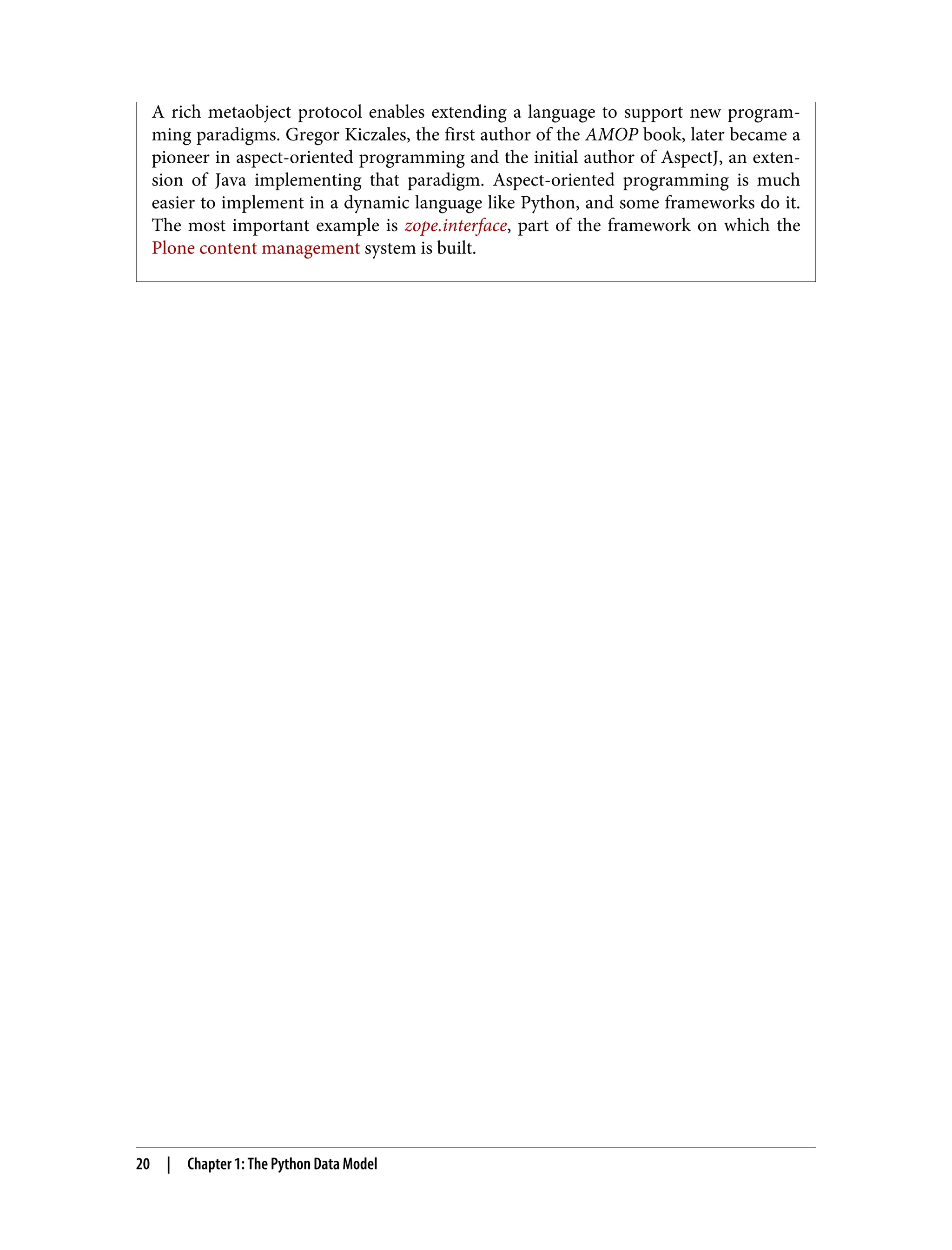Fluent Python Clear Concise And Effective Programming 2nd Edition 2nd Luciano Ramalho Fluent Python Clear Concise And Effective Programming 2nd Edition 2nd Luciano Ramalho Fluent Python Clear Concise And Effective Programming 2nd Edition 2nd Luciano Ramalho
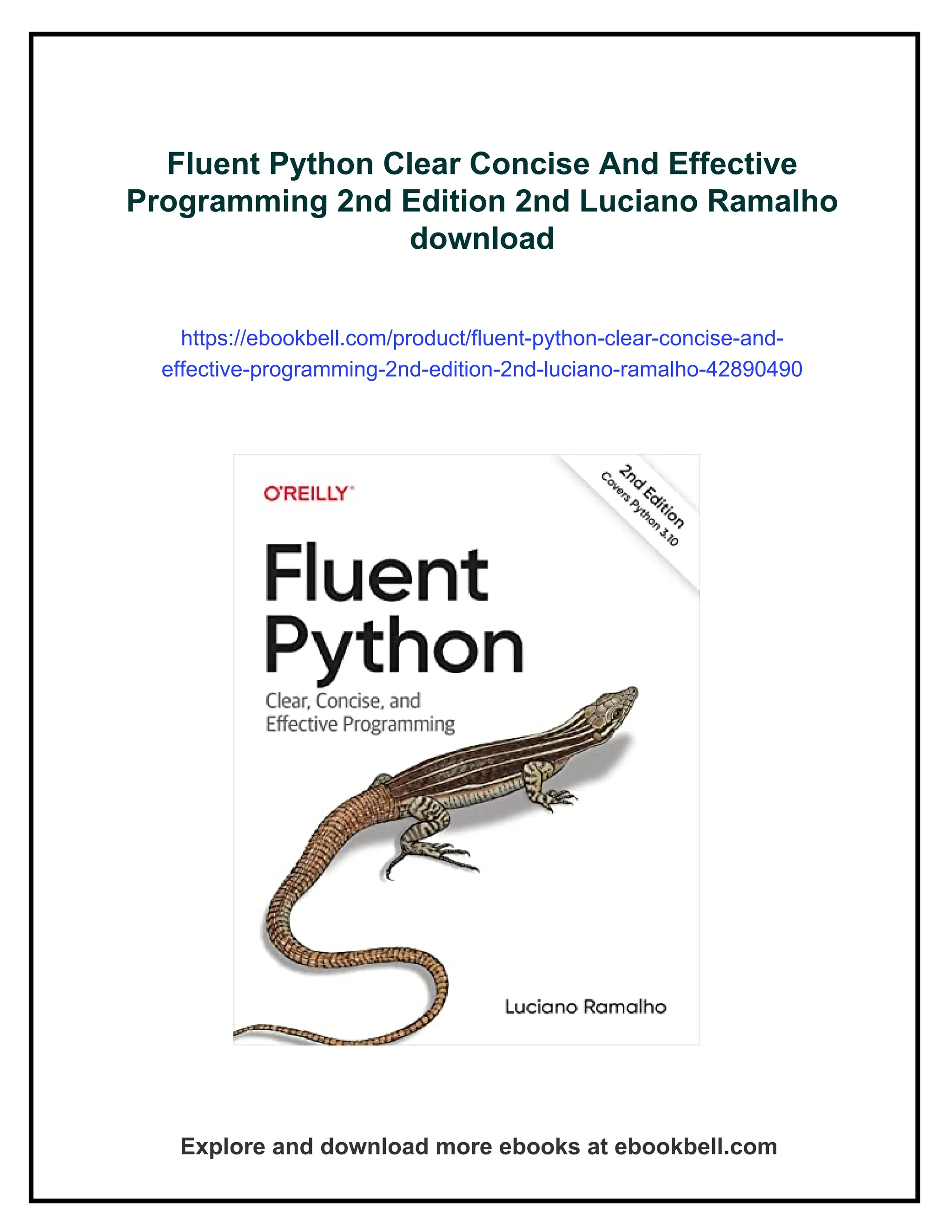

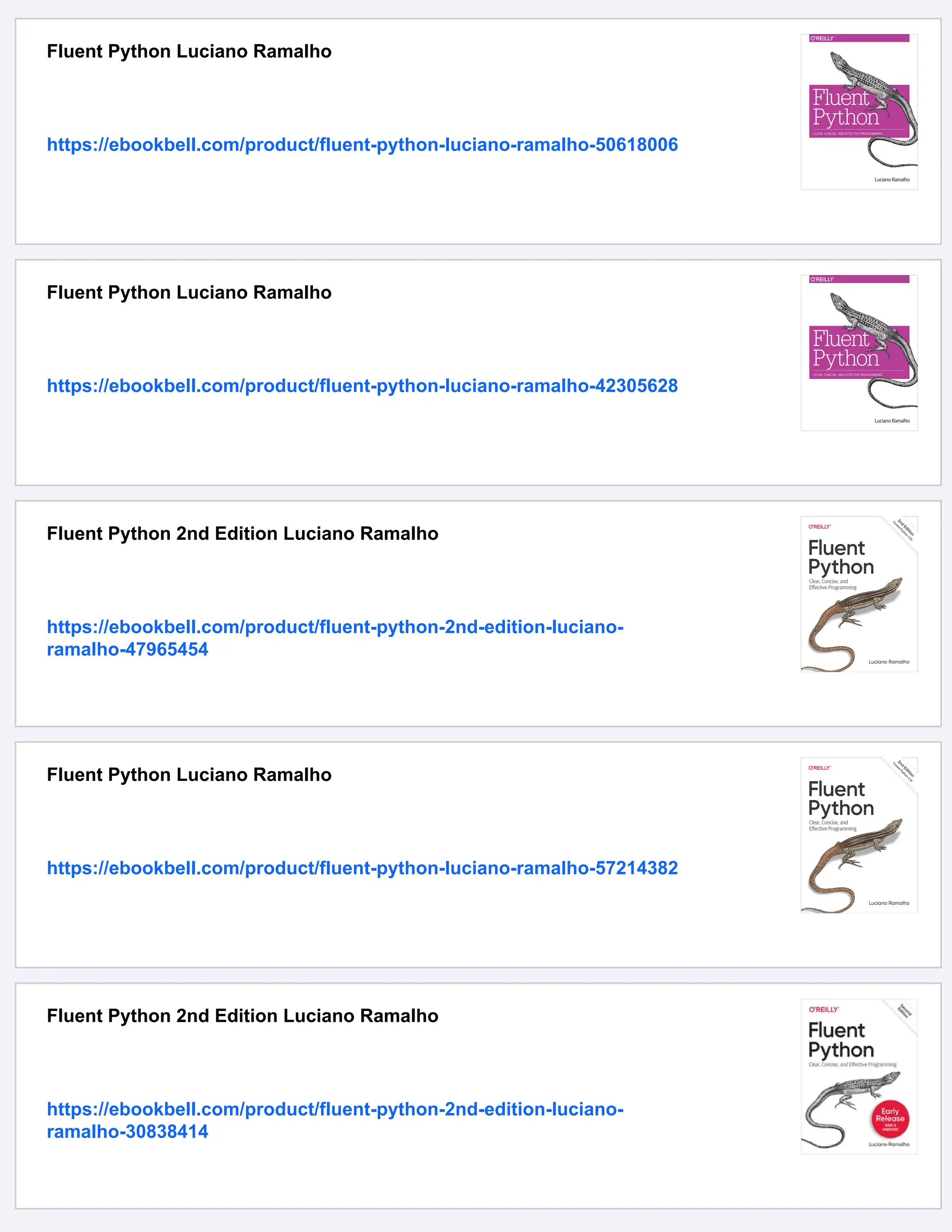


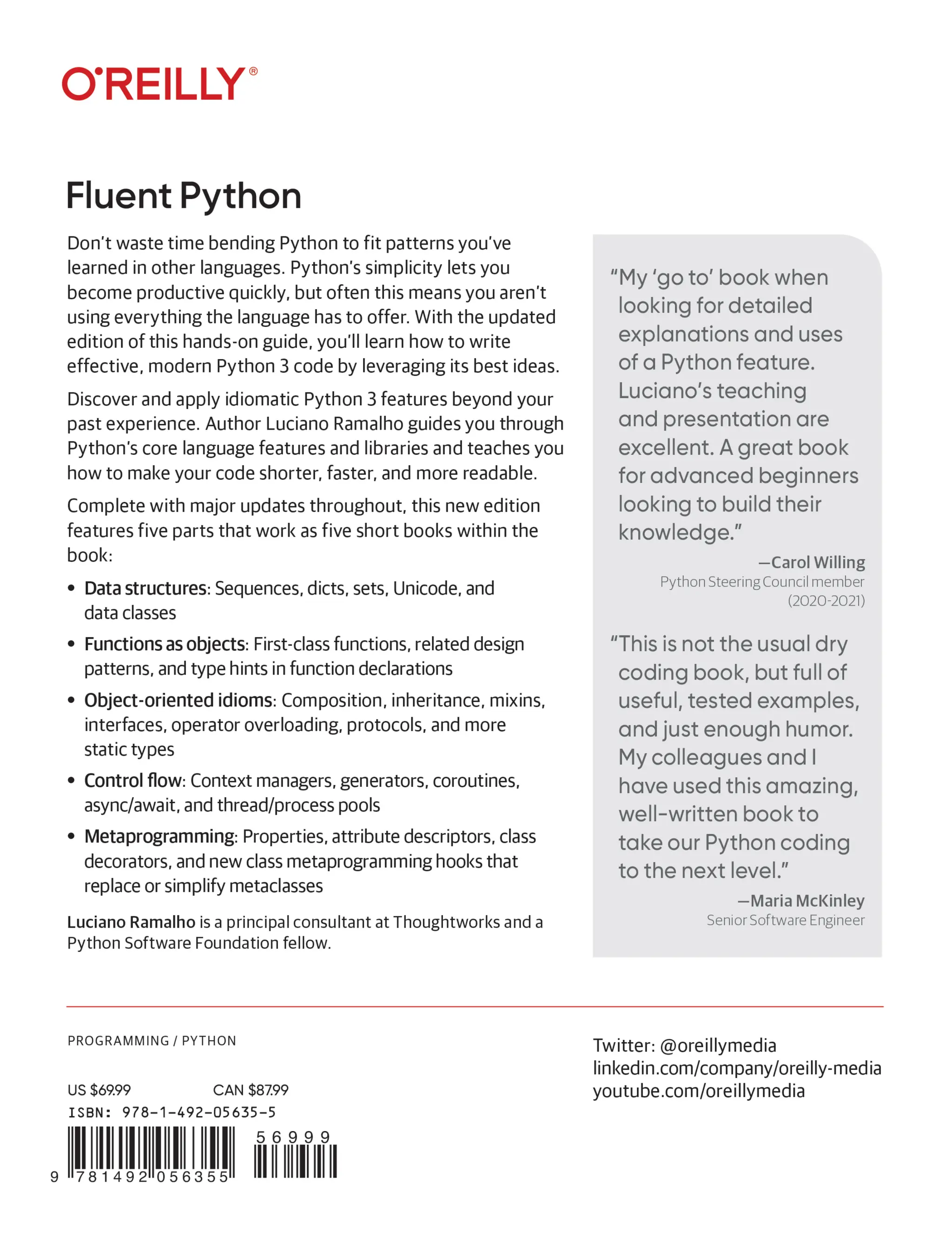
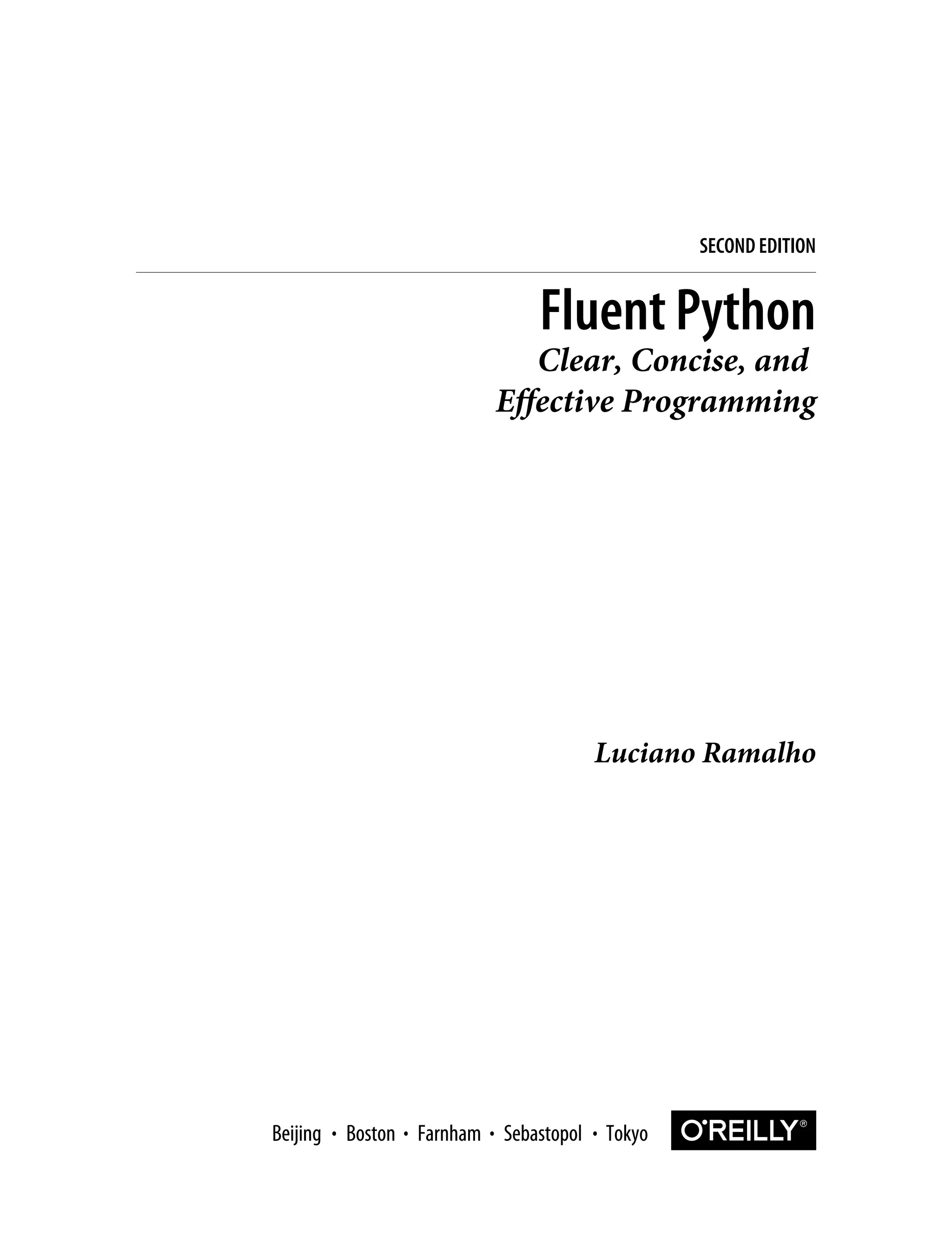
![978-1-492-05635-5 [LSI] Fluent Python by Luciano Ramalho Copyright © 2022 Luciano Ramalho. All rights reserved. Printed in the United States of America. Published by O’Reilly Media, Inc., 1005 Gravenstein Highway North, Sebastopol, CA 95472. O’Reilly books may be purchased for educational, business, or sales promotional use. Online editions are also available for most titles (http://oreilly.com). For more information, contact our corporate/institu‐ tional sales department: 800-998-9938 or corporate@oreilly.com. Acquisitions Editor: Amanda Quinn Development Editor: Jeff Bleiel Production Editor: Daniel Elfanbaum Copyeditor: Sonia Saruba Proofreader: Kim Cofer Indexer: Judith McConville Interior Designer: David Futato Cover Designer: Karen Montgomery Illustrator: Kate Dullea April 2022: Second Edition Revision History for the Second Edition 2022-03-31: First Release See http://oreilly.com/catalog/errata.csp?isbn=9781492056355 for release details. The O’Reilly logo is a registered trademark of O’Reilly Media, Inc. Fluent Python, the cover image, and related trade dress are trademarks of O’Reilly Media, Inc. The views expressed in this work are those of the author and do not represent the publisher’s views. While the publisher and the author have used good faith efforts to ensure that the information and instructions contained in this work are accurate, the publisher and the author disclaim all responsibility for errors or omissions, including without limitation responsibility for damages resulting from the use of or reliance on this work. Use of the information and instructions contained in this work is at your own risk. If any code samples or other technology this work contains or describes is subject to open source licenses or the intellectual property rights of others, it is your responsibility to ensure that your use thereof complies with such licenses and/or rights.](https://image.slidesharecdn.com/21445245-250528041545-5f2101ef/75/Fluent-Python-Clear-Concise-And-Effective-Programming-2nd-Edition-2nd-Luciano-Ramalho-8-2048.jpg)


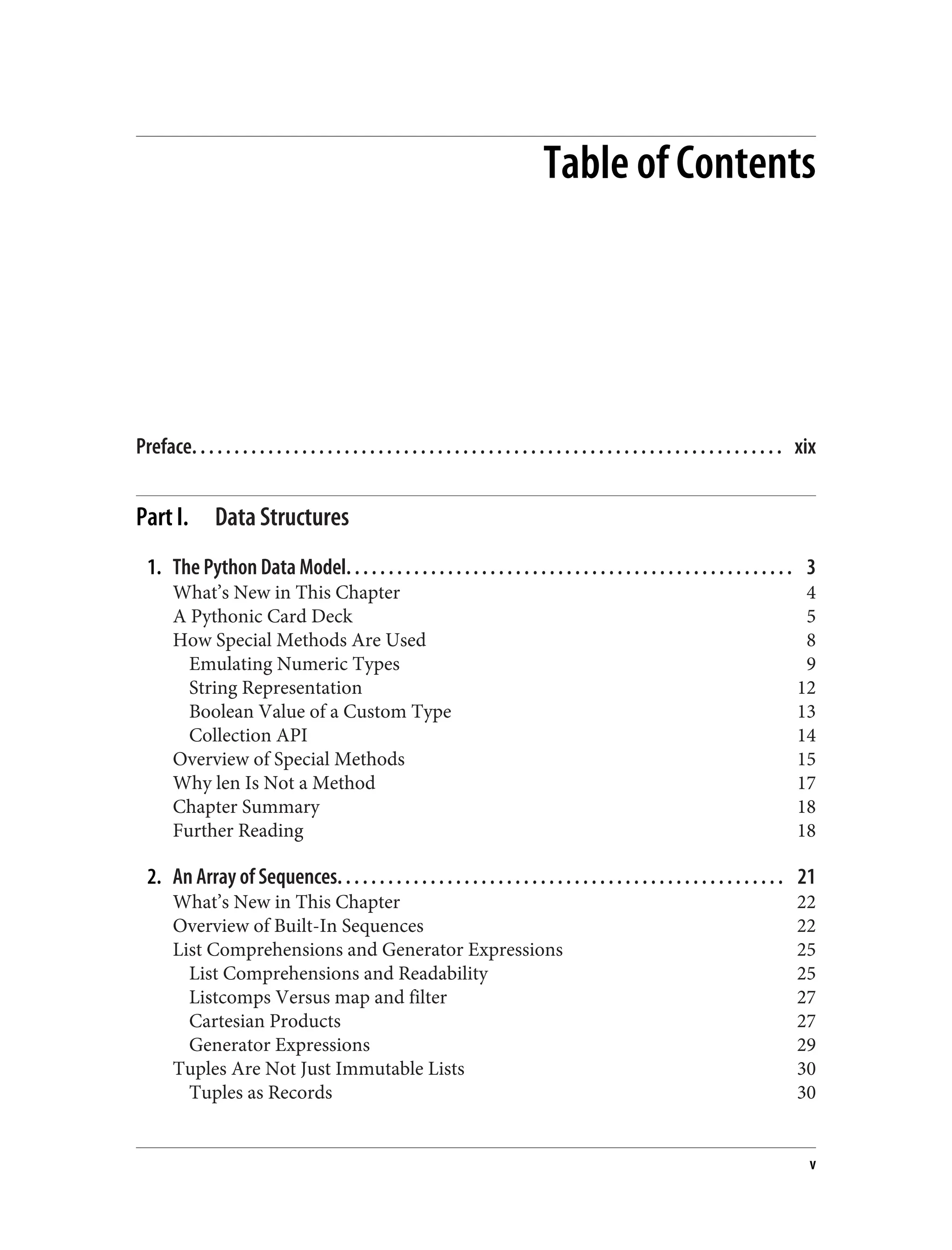

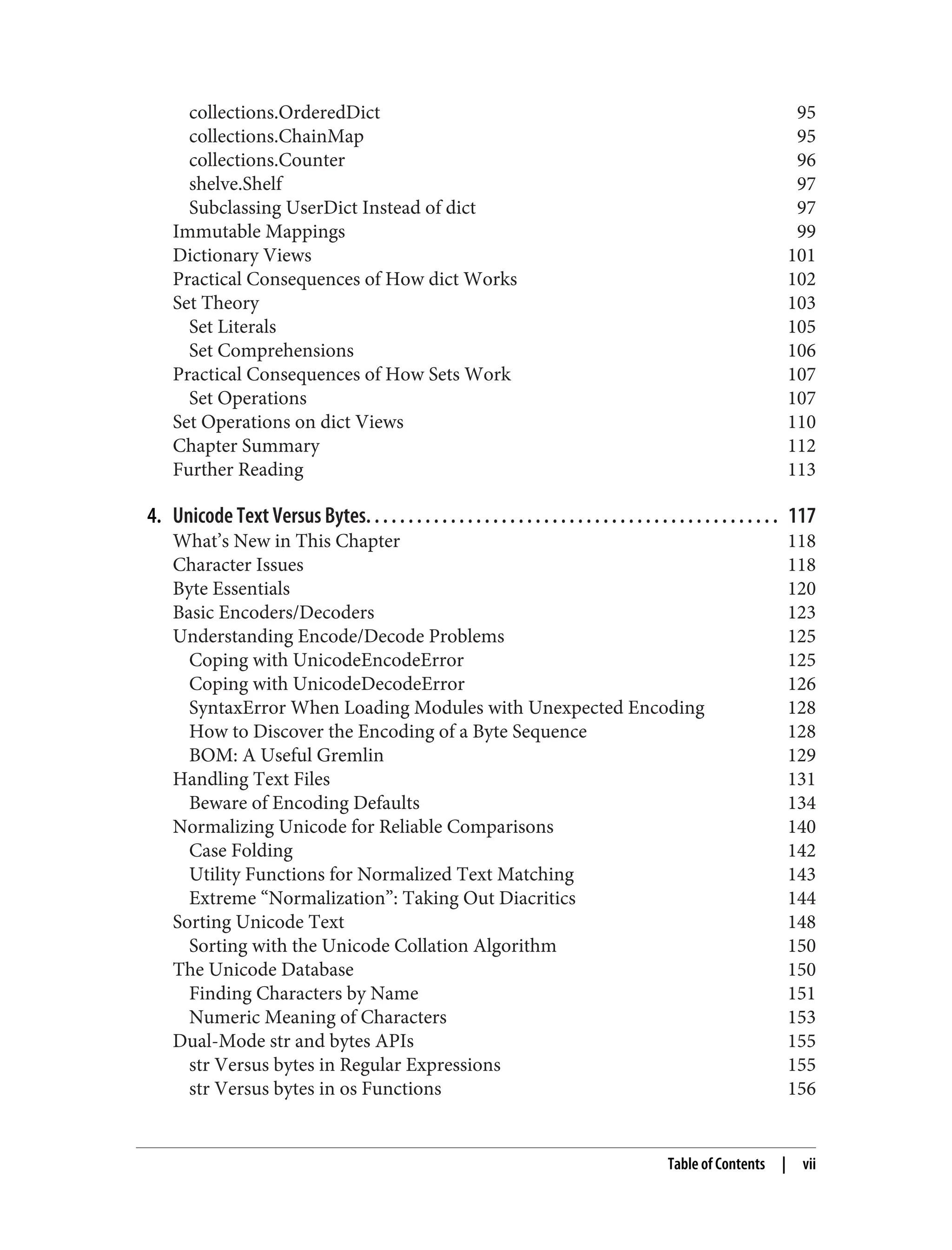

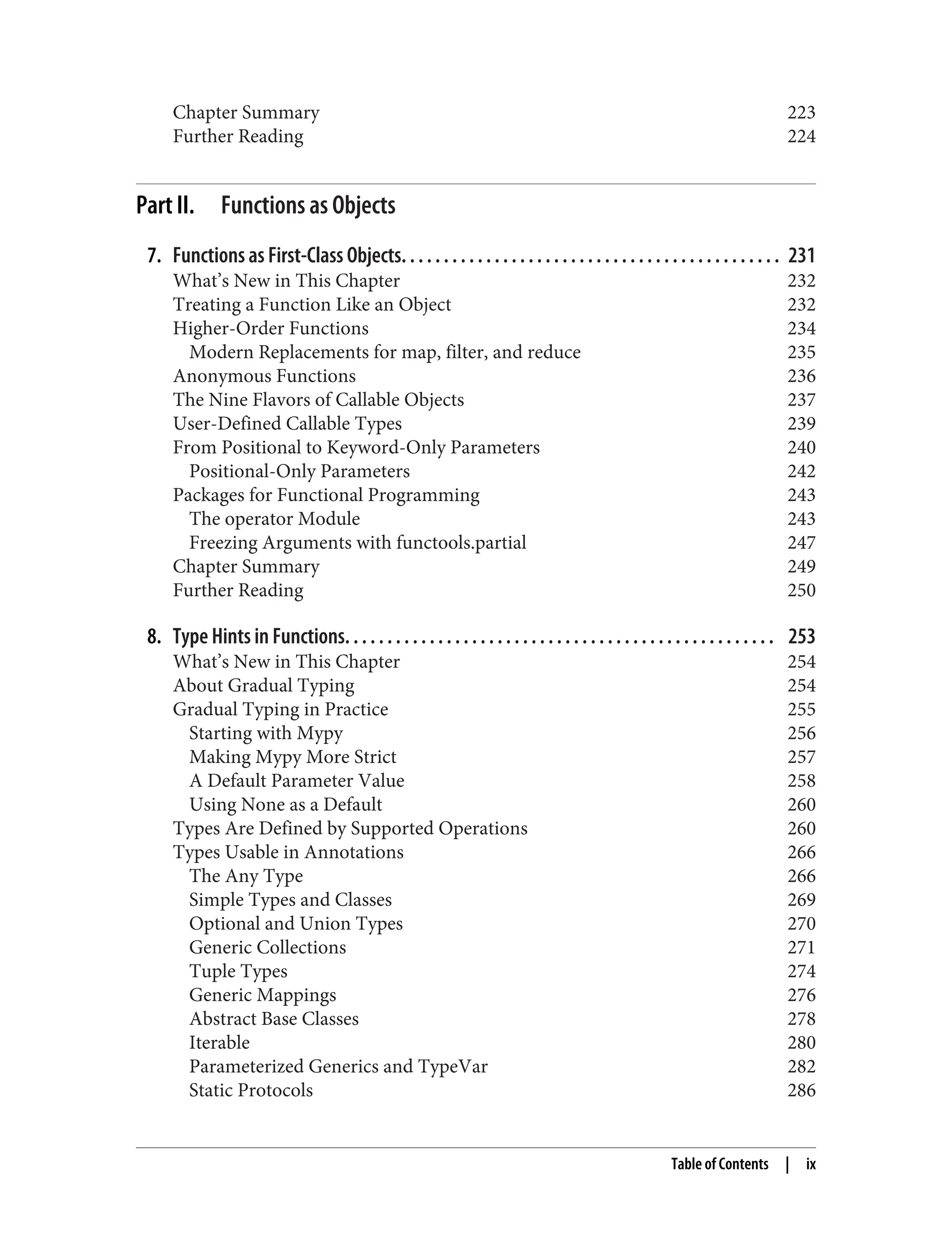
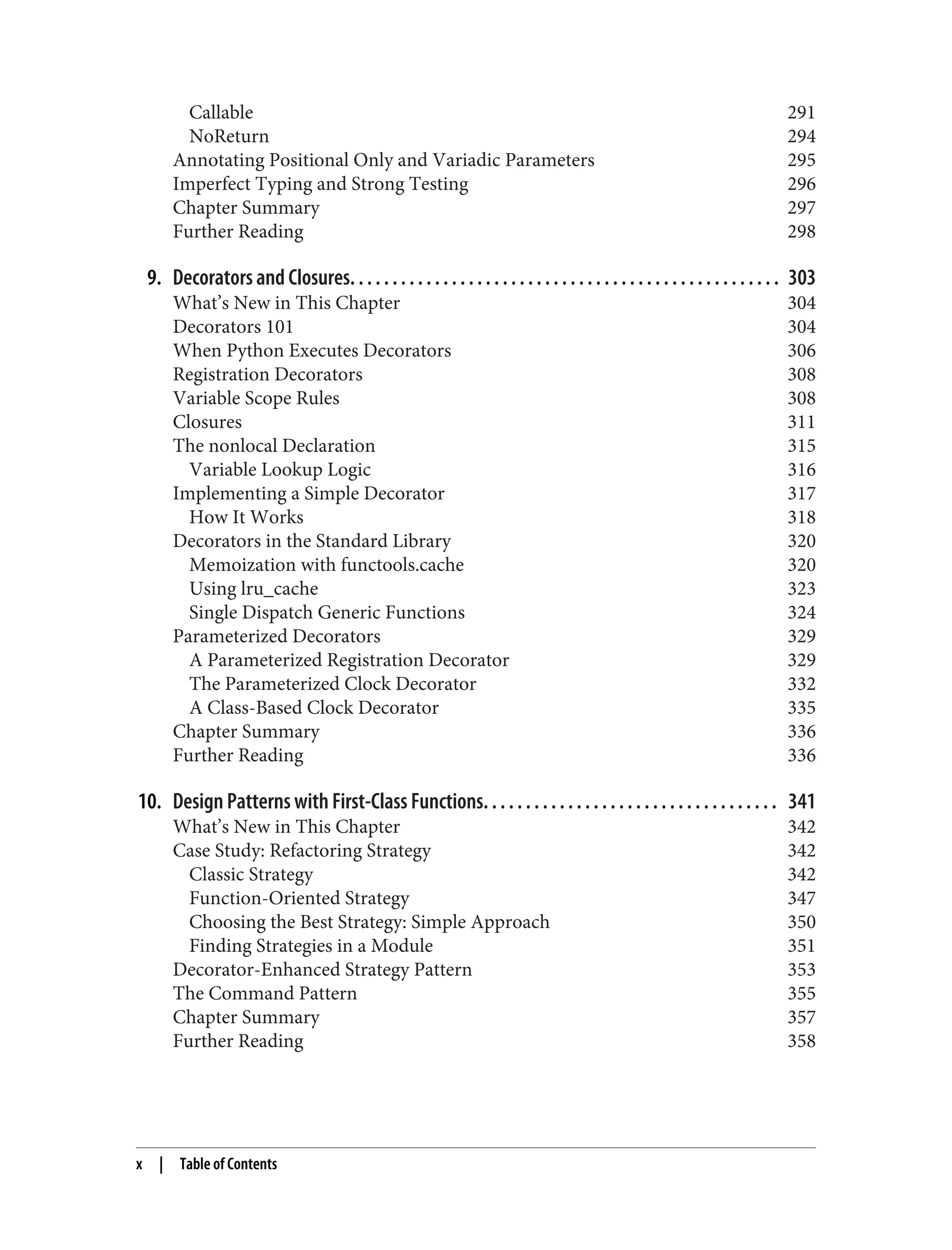
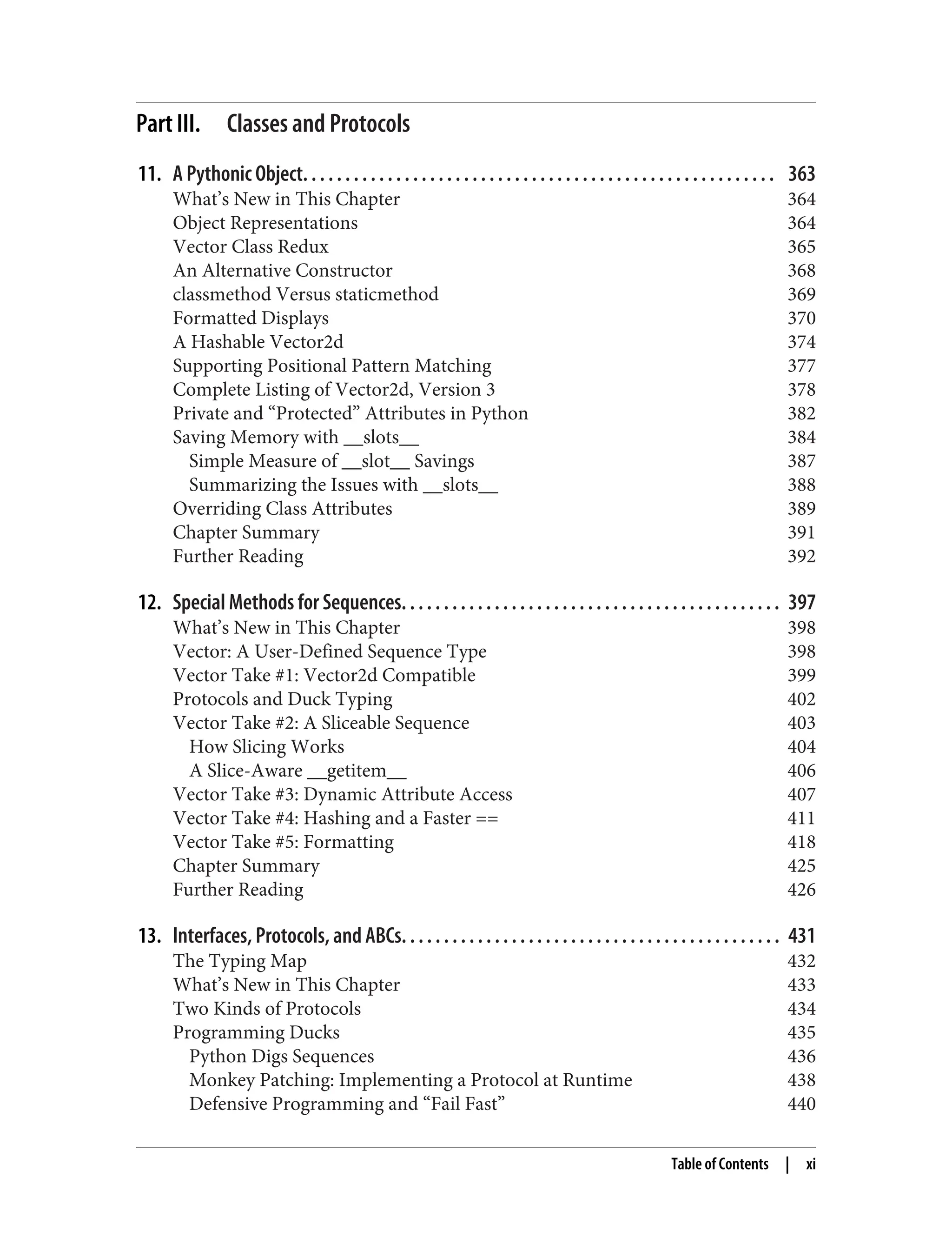
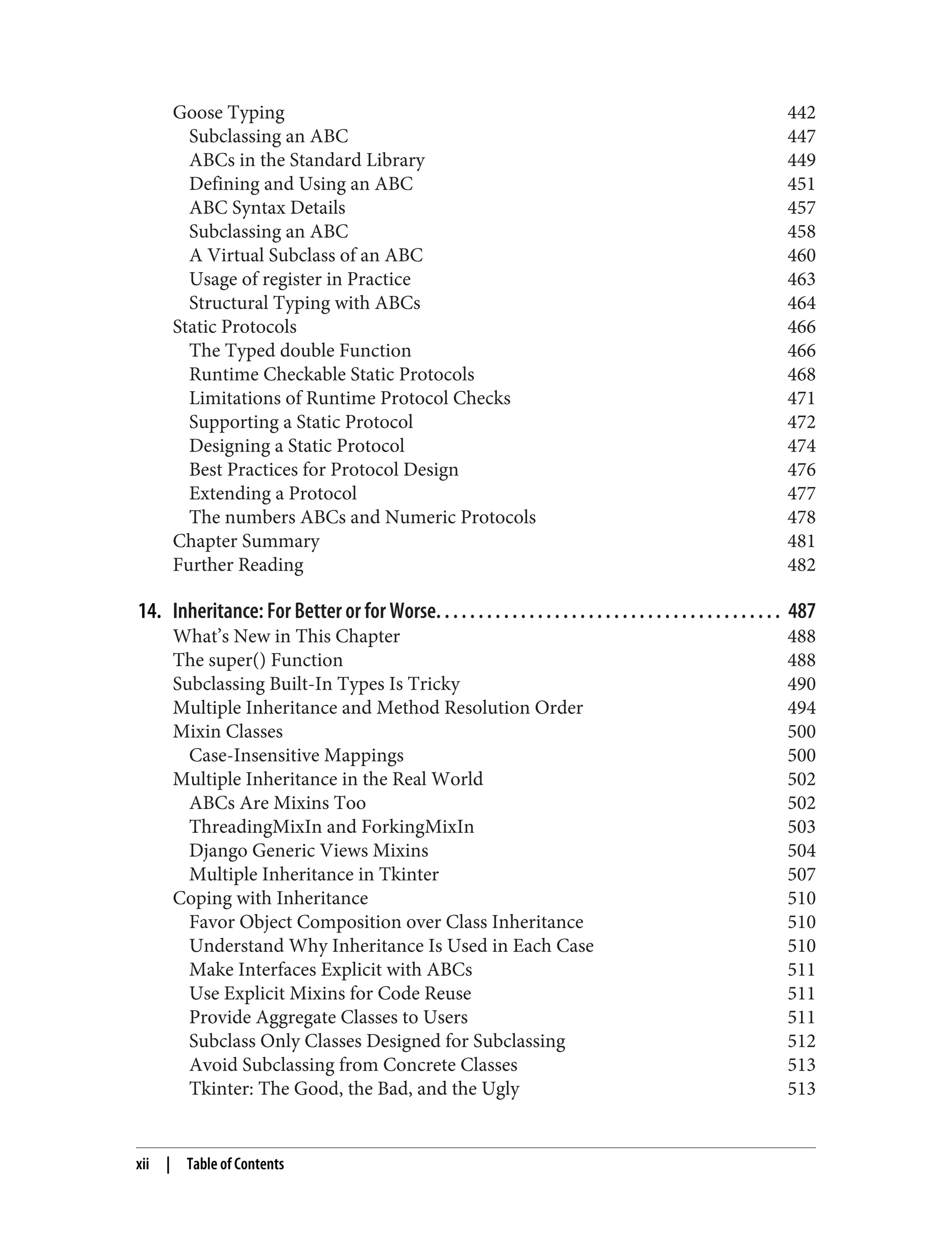
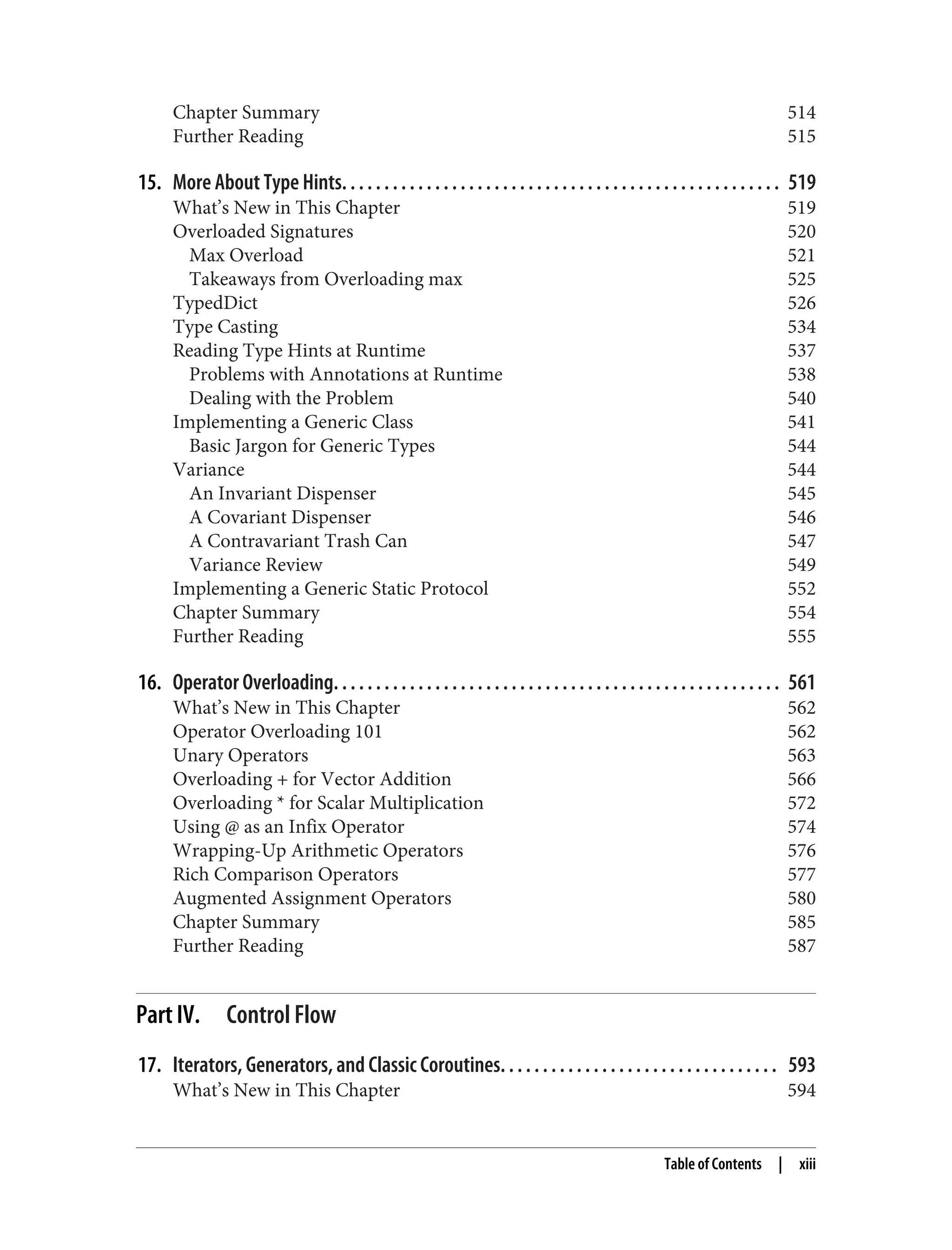
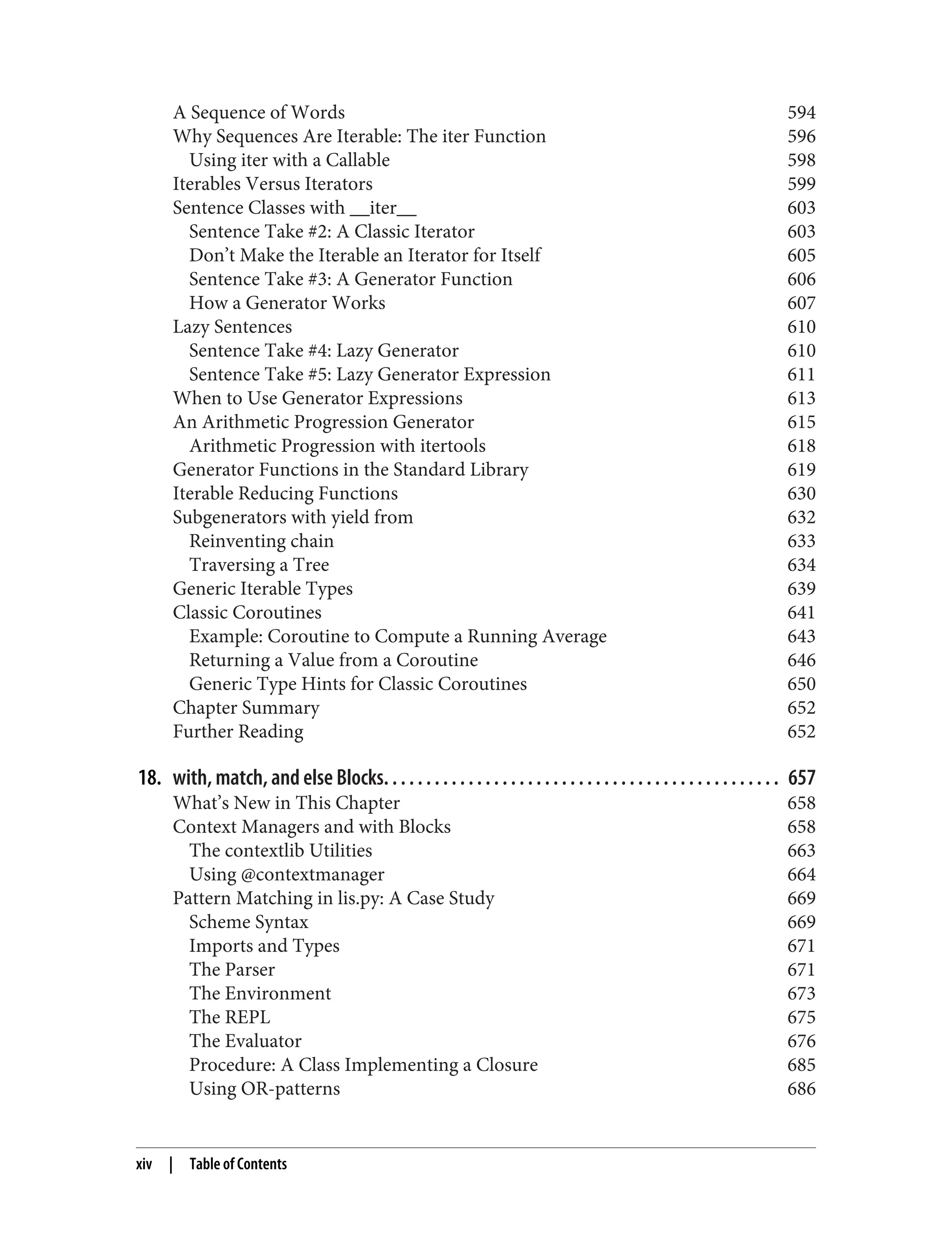
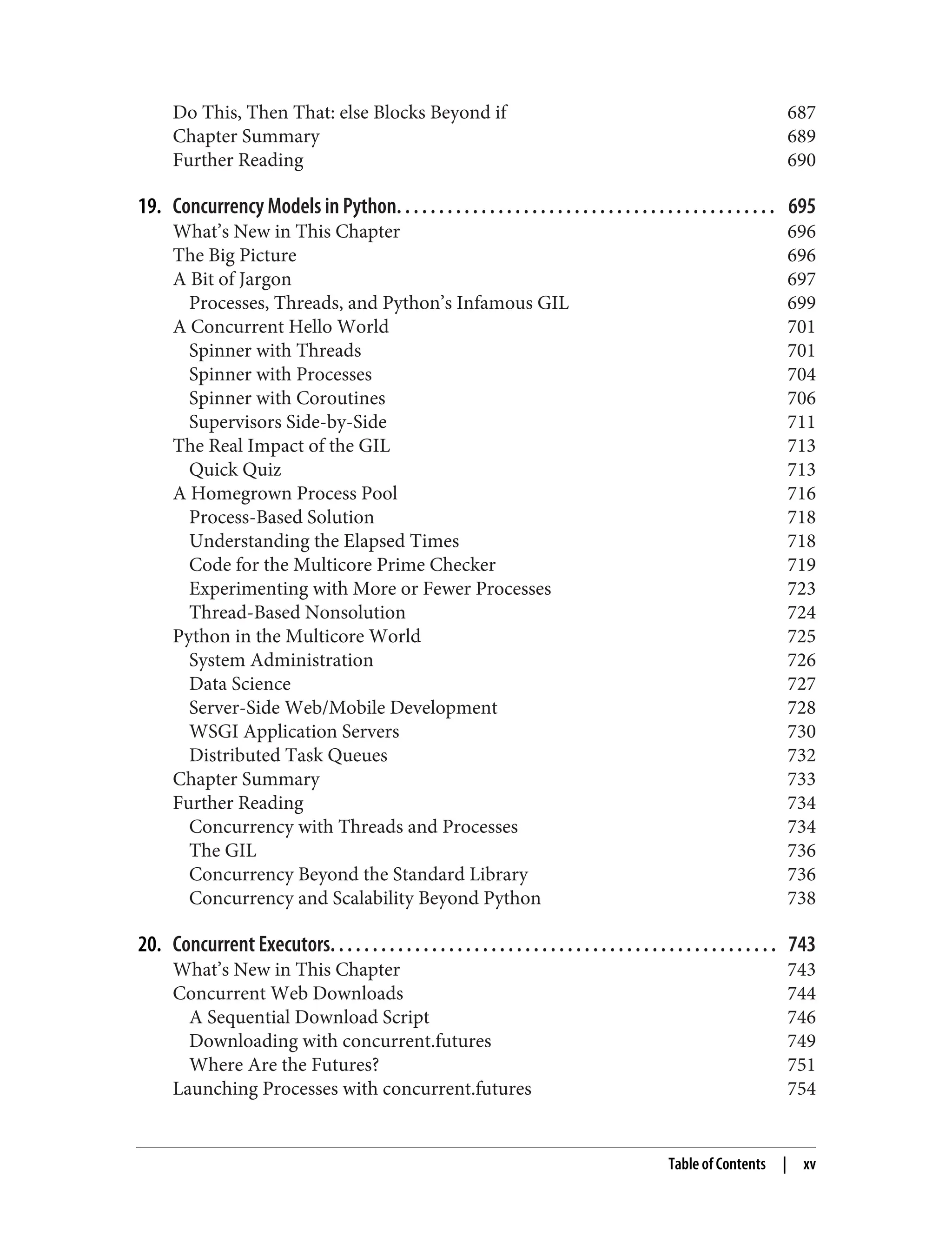


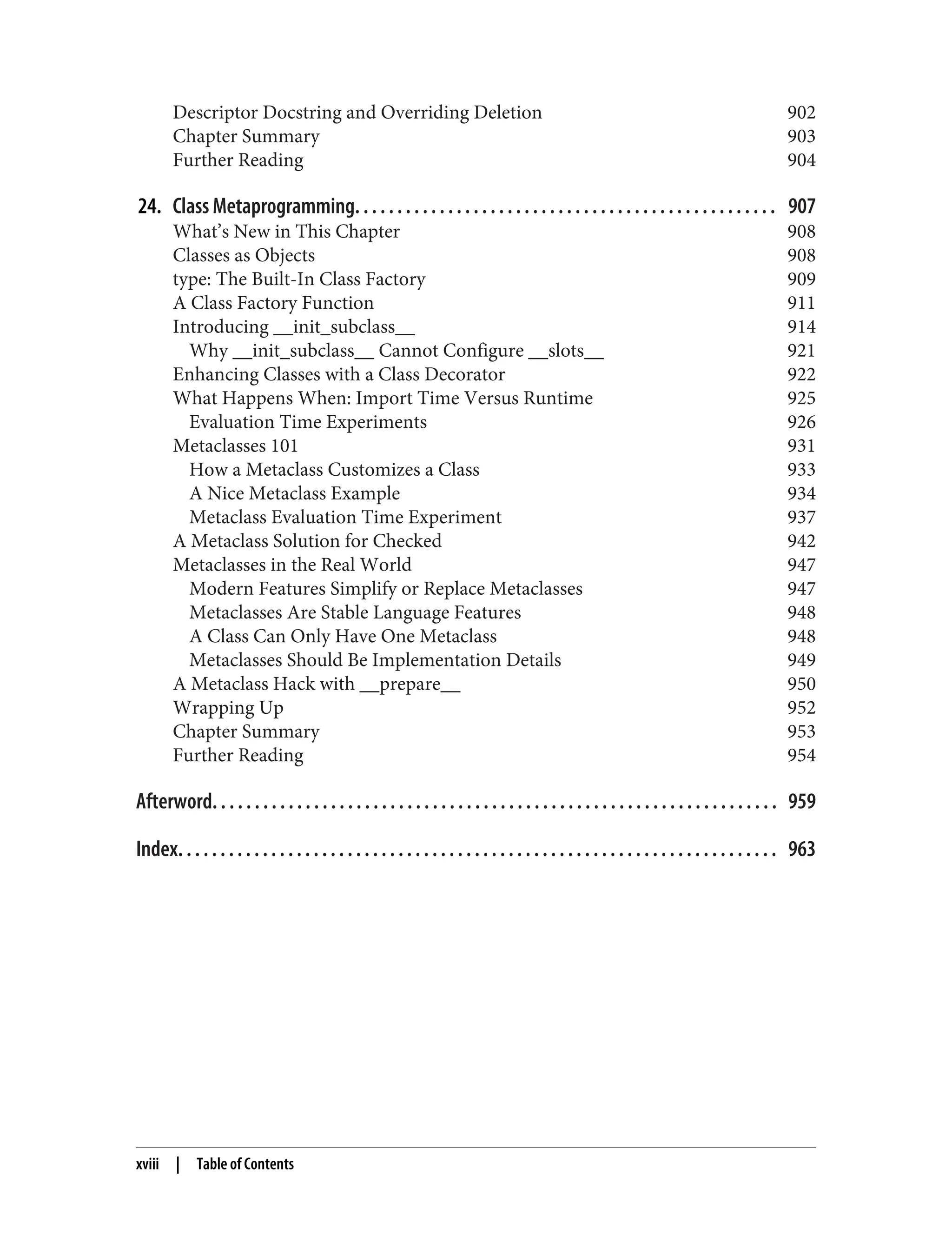
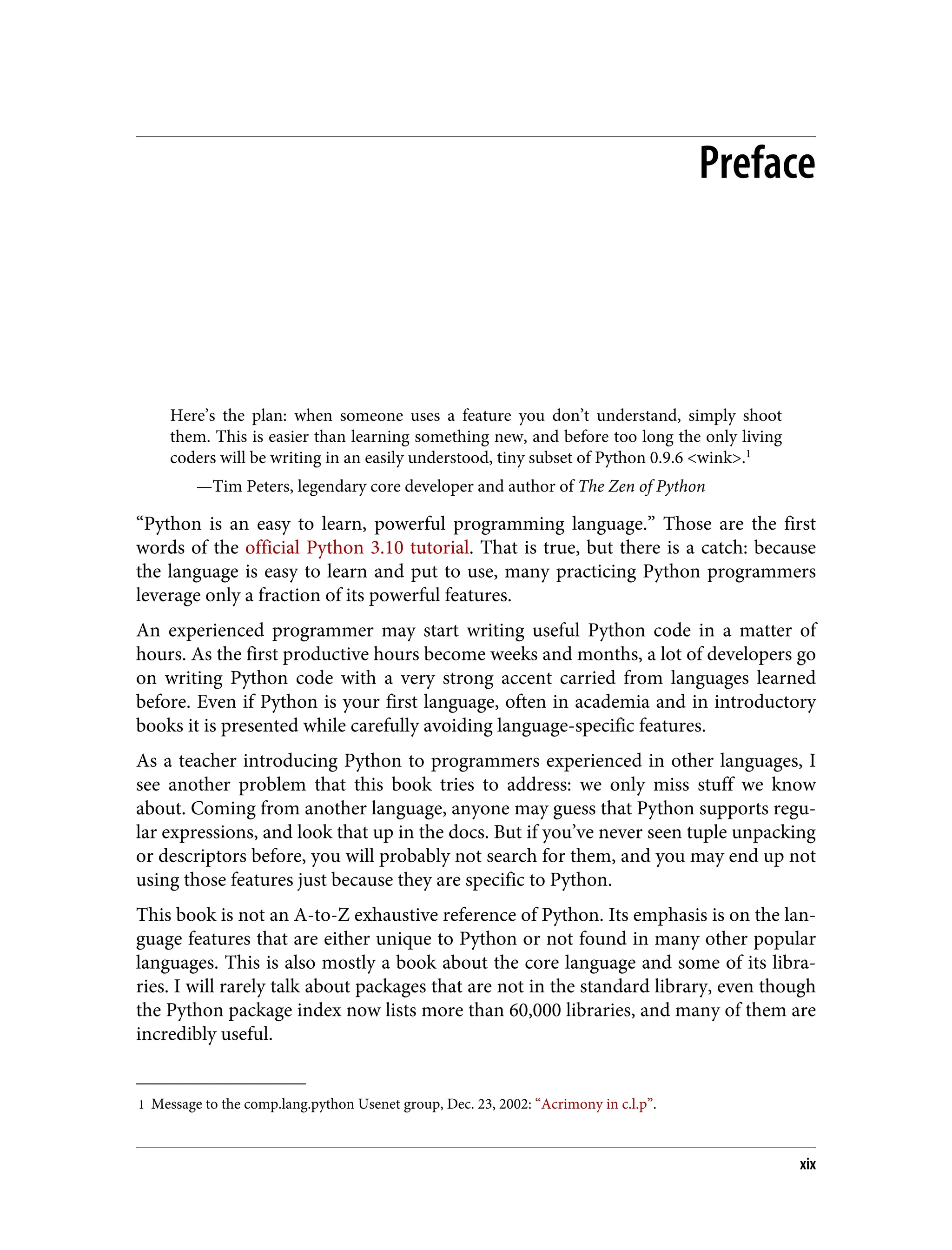

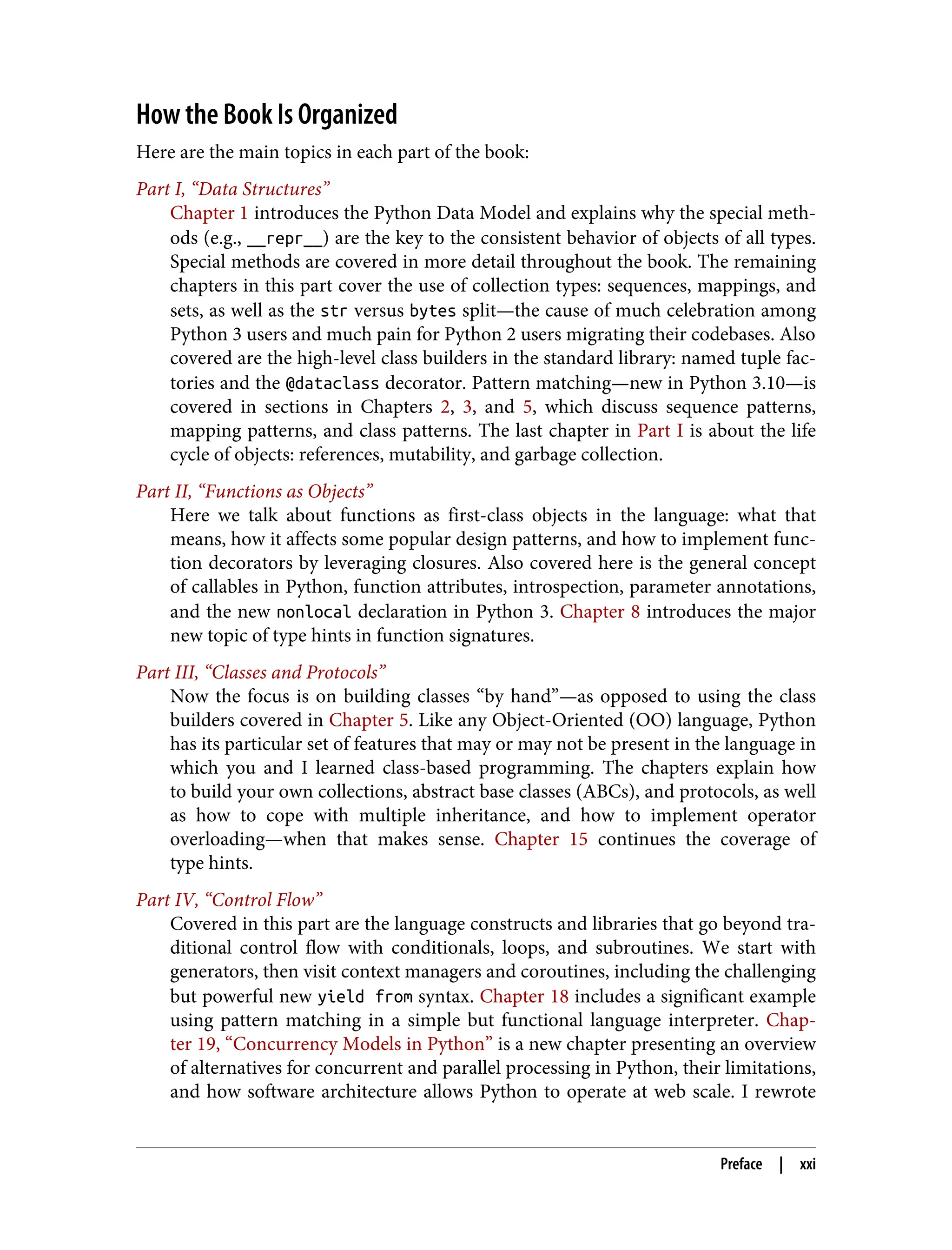

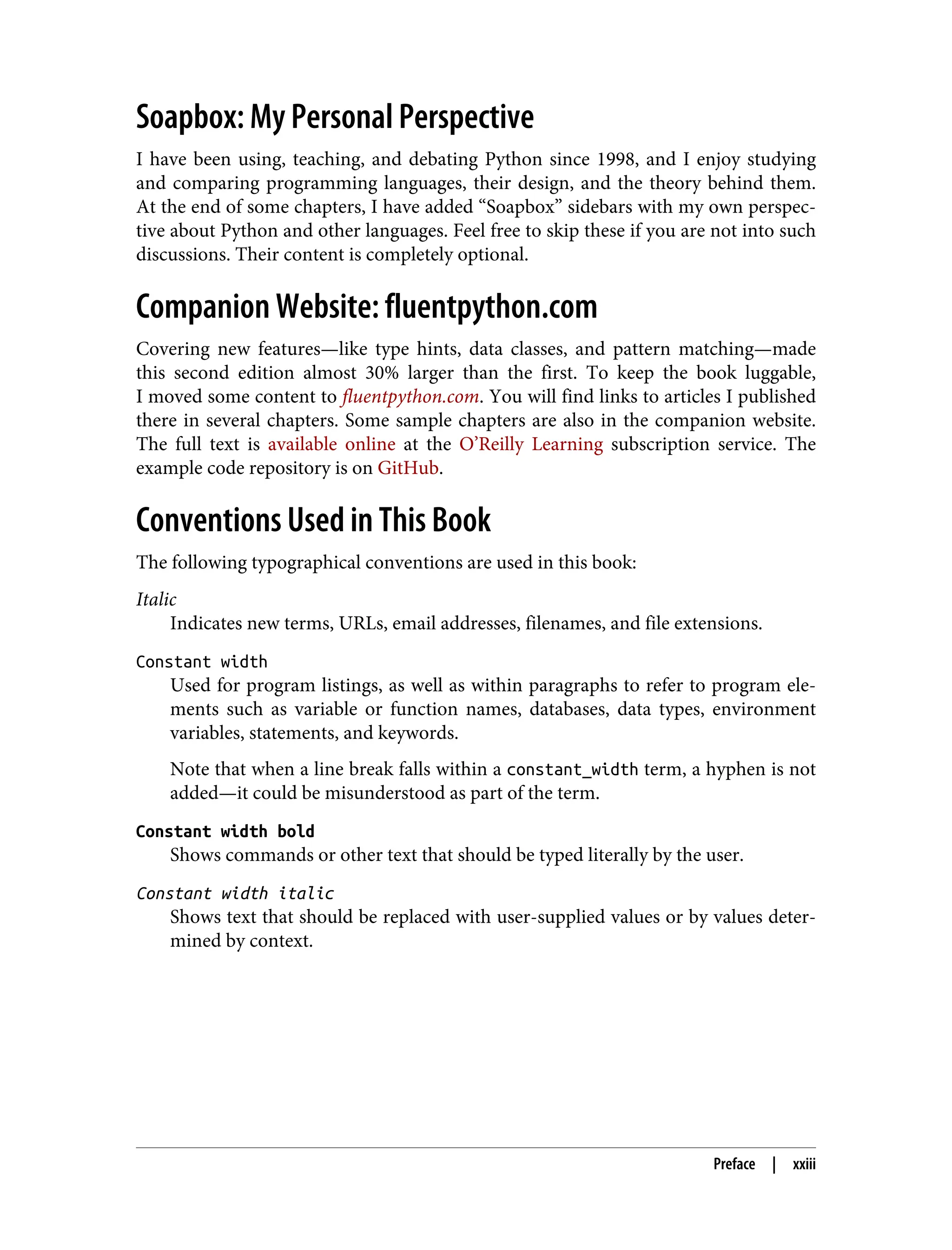
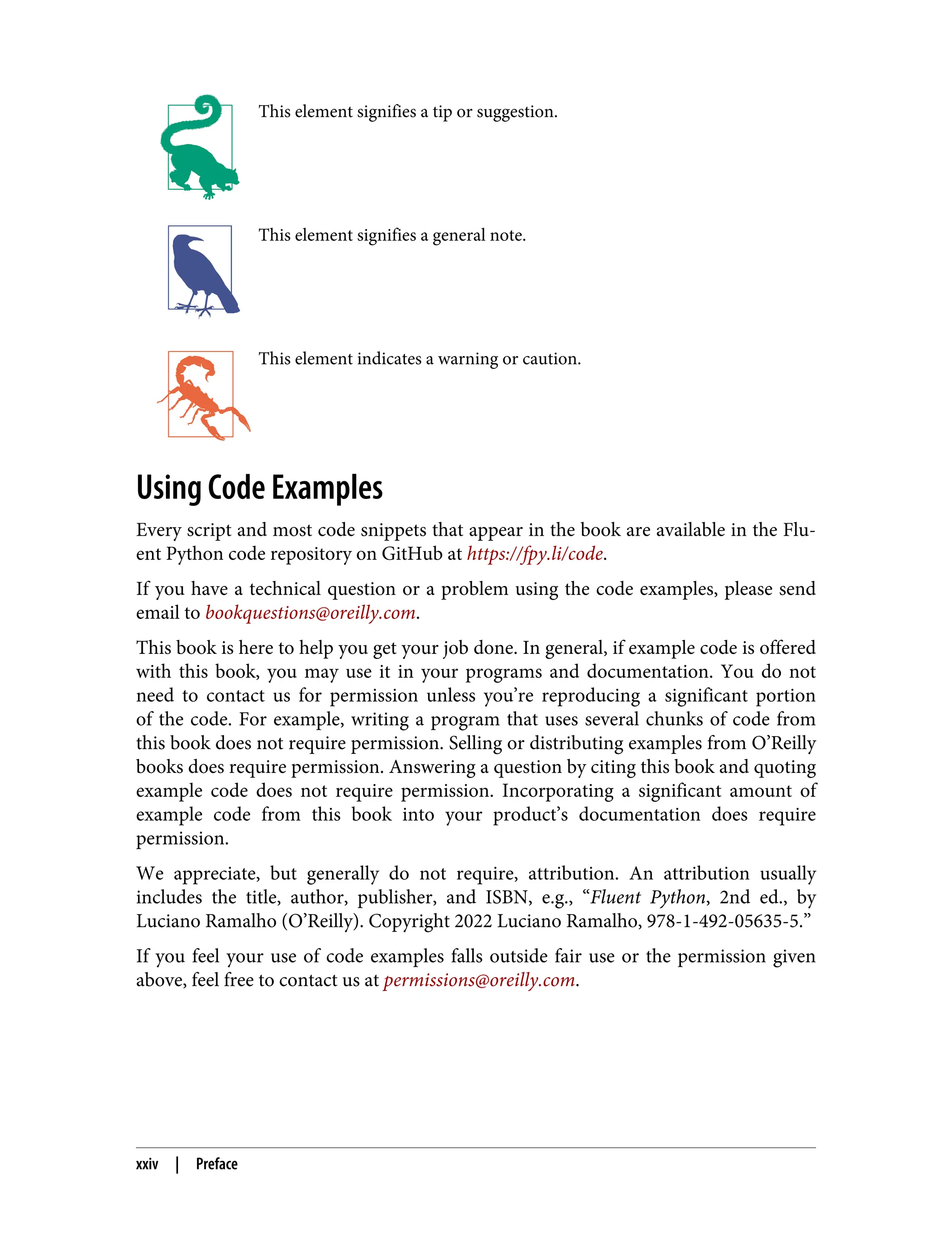


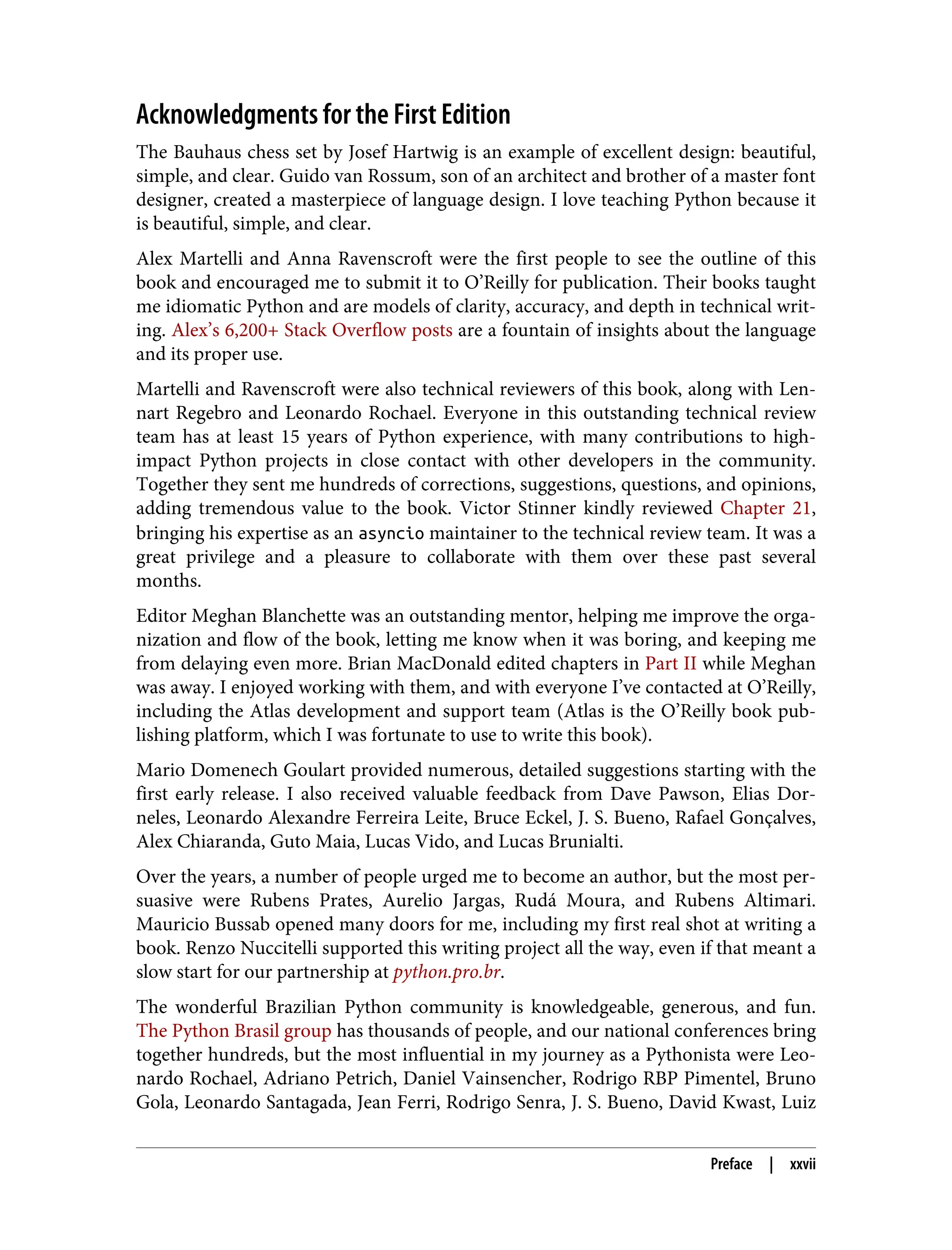



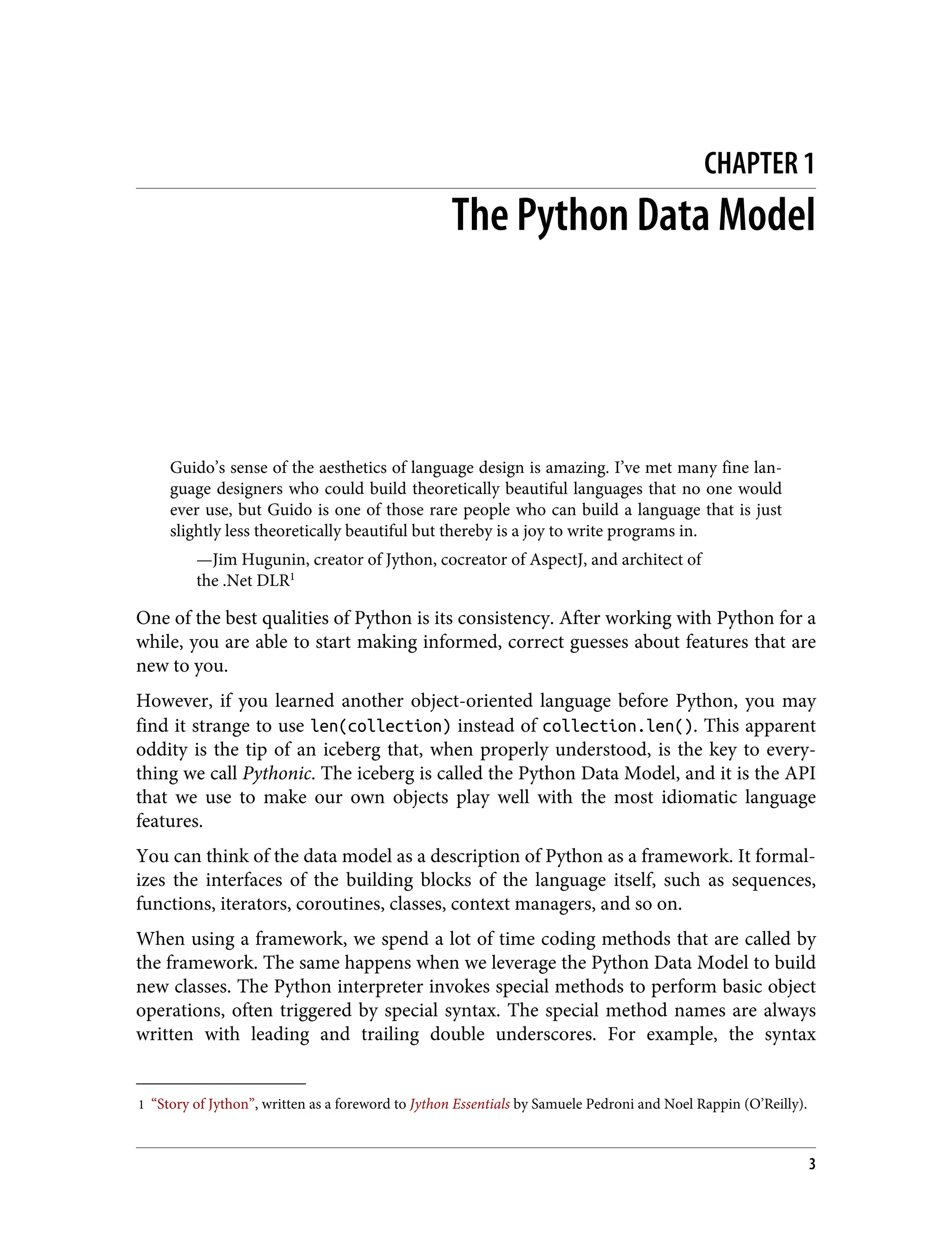
![obj[key] is supported by the __getitem__ special method. In order to evaluate my_collection[key], the interpreter calls my_collection.__getitem__(key). We implement special methods when we want our objects to support and interact with fundamental language constructs such as: • Collections • Attribute access • Iteration (including asynchronous iteration using async for) • Operator overloading • Function and method invocation • String representation and formatting • Asynchronous programming using await • Object creation and destruction • Managed contexts using the with or async with statements Magic and Dunder The term magic method is slang for special method, but how do we talk about a specific method like __getitem__? I learned to say “dunder-getitem” from author and teacher Steve Holden. “Dun‐ der” is a shortcut for “double underscore before and after.” That’s why the special methods are also known as dunder methods. The “Lexical Analysis” chapter of The Python Language Reference warns that “Any use of __*__ names, in any context, that does not follow explicitly documented use, is subject to breakage without warning.” What’s New in This Chapter This chapter had few changes from the first edition because it is an introduction to the Python Data Model, which is quite stable. The most significant changes are: • Special methods supporting asynchronous programming and other new features, added to the tables in “Overview of Special Methods” on page 15. • Figure 1-2 showing the use of special methods in “Collection API” on page 14, including the collections.abc.Collection abstract base class introduced in Python 3.6. 4 | Chapter 1: The Python Data Model](https://image.slidesharecdn.com/21445245-250528041545-5f2101ef/75/Fluent-Python-Clear-Concise-And-Effective-Programming-2nd-Edition-2nd-Luciano-Ramalho-38-2048.jpg)
![Also, here and throughout this second edition I adopted the f-string syntax intro‐ duced in Python 3.6, which is more readable and often more convenient than the older string formatting notations: the str.format() method and the % operator. One reason to still use my_fmt.format() is when the definition of my_fmt must be in a different place in the code than where the for‐ matting operation needs to happen. For instance, when my_fmt has multiple lines and is better defined in a constant, or when it must come from a configuration file, or from the database. Those are real needs, but don’t happen very often. A Pythonic Card Deck Example 1-1 is simple, but it demonstrates the power of implementing just two spe‐ cial methods, __getitem__ and __len__. Example 1-1. A deck as a sequence of playing cards import collections Card = collections.namedtuple('Card', ['rank', 'suit']) class FrenchDeck: ranks = [str(n) for n in range(2, 11)] + list('JQKA') suits = 'spades diamonds clubs hearts'.split() def __init__(self): self._cards = [Card(rank, suit) for suit in self.suits for rank in self.ranks] def __len__(self): return len(self._cards) def __getitem__(self, position): return self._cards[position] The first thing to note is the use of collections.namedtuple to construct a simple class to represent individual cards. We use namedtuple to build classes of objects that are just bundles of attributes with no custom methods, like a database record. In the example, we use it to provide a nice representation for the cards in the deck, as shown in the console session: >>> beer_card = Card('7', 'diamonds') >>> beer_card Card(rank='7', suit='diamonds') A Pythonic Card Deck | 5](https://image.slidesharecdn.com/21445245-250528041545-5f2101ef/75/Fluent-Python-Clear-Concise-And-Effective-Programming-2nd-Edition-2nd-Luciano-Ramalho-39-2048.jpg)
![But the point of this example is the FrenchDeck class. It’s short, but it packs a punch. First, like any standard Python collection, a deck responds to the len() function by returning the number of cards in it: >>> deck = FrenchDeck() >>> len(deck) 52 Reading specific cards from the deck—say, the first or the last—is easy, thanks to the __getitem__ method: >>> deck[0] Card(rank='2', suit='spades') >>> deck[-1] Card(rank='A', suit='hearts') Should we create a method to pick a random card? No need. Python already has a function to get a random item from a sequence: random.choice. We can use it on a deck instance: >>> from random import choice >>> choice(deck) Card(rank='3', suit='hearts') >>> choice(deck) Card(rank='K', suit='spades') >>> choice(deck) Card(rank='2', suit='clubs') We’ve just seen two advantages of using special methods to leverage the Python Data Model: • Users of your classes don’t have to memorize arbitrary method names for stan‐ dard operations. (“How to get the number of items? Is it .size(), .length(), or what?”) • It’s easier to benefit from the rich Python standard library and avoid reinventing the wheel, like the random.choice function. But it gets better. Because our __getitem__ delegates to the [] operator of self._cards, our deck automatically supports slicing. Here’s how we look at the top three cards from a brand-new deck, and then pick just the aces by starting at index 12 and skipping 13 cards at a time: >>> deck[:3] [Card(rank='2', suit='spades'), Card(rank='3', suit='spades'), Card(rank='4', suit='spades')] >>> deck[12::13] [Card(rank='A', suit='spades'), Card(rank='A', suit='diamonds'), Card(rank='A', suit='clubs'), Card(rank='A', suit='hearts')] 6 | Chapter 1: The Python Data Model](https://image.slidesharecdn.com/21445245-250528041545-5f2101ef/75/Fluent-Python-Clear-Concise-And-Effective-Programming-2nd-Edition-2nd-Luciano-Ramalho-40-2048.jpg)
![Just by implementing the __getitem__ special method, our deck is also iterable: >>> for card in deck: # doctest: +ELLIPSIS ... print(card) Card(rank='2', suit='spades') Card(rank='3', suit='spades') Card(rank='4', suit='spades') ... We can also iterate over the deck in reverse: >>> for card in reversed(deck): # doctest: +ELLIPSIS ... print(card) Card(rank='A', suit='hearts') Card(rank='K', suit='hearts') Card(rank='Q', suit='hearts') ... Ellipsis in doctests Whenever possible, I extracted the Python console listings in this book from doctest to ensure accuracy. When the output was too long, the elided part is marked by an ellipsis (...), like in the last line in the preceding code. In such cases, I used the # doctest: +ELLIPSIS directive to make the doctest pass. If you are trying these examples in the interactive console, you may omit the doctest comments altogether. Iteration is often implicit. If a collection has no __contains__ method, the in opera‐ tor does a sequential scan. Case in point: in works with our FrenchDeck class because it is iterable. Check it out: >>> Card('Q', 'hearts') in deck True >>> Card('7', 'beasts') in deck False How about sorting? A common system of ranking cards is by rank (with aces being highest), then by suit in the order of spades (highest), hearts, diamonds, and clubs (lowest). Here is a function that ranks cards by that rule, returning 0 for the 2 of clubs and 51 for the ace of spades: suit_values = dict(spades=3, hearts=2, diamonds=1, clubs=0) def spades_high(card): rank_value = FrenchDeck.ranks.index(card.rank) return rank_value * len(suit_values) + suit_values[card.suit] Given spades_high, we can now list our deck in order of increasing rank: A Pythonic Card Deck | 7](https://image.slidesharecdn.com/21445245-250528041545-5f2101ef/75/Fluent-Python-Clear-Concise-And-Effective-Programming-2nd-Edition-2nd-Luciano-Ramalho-41-2048.jpg)
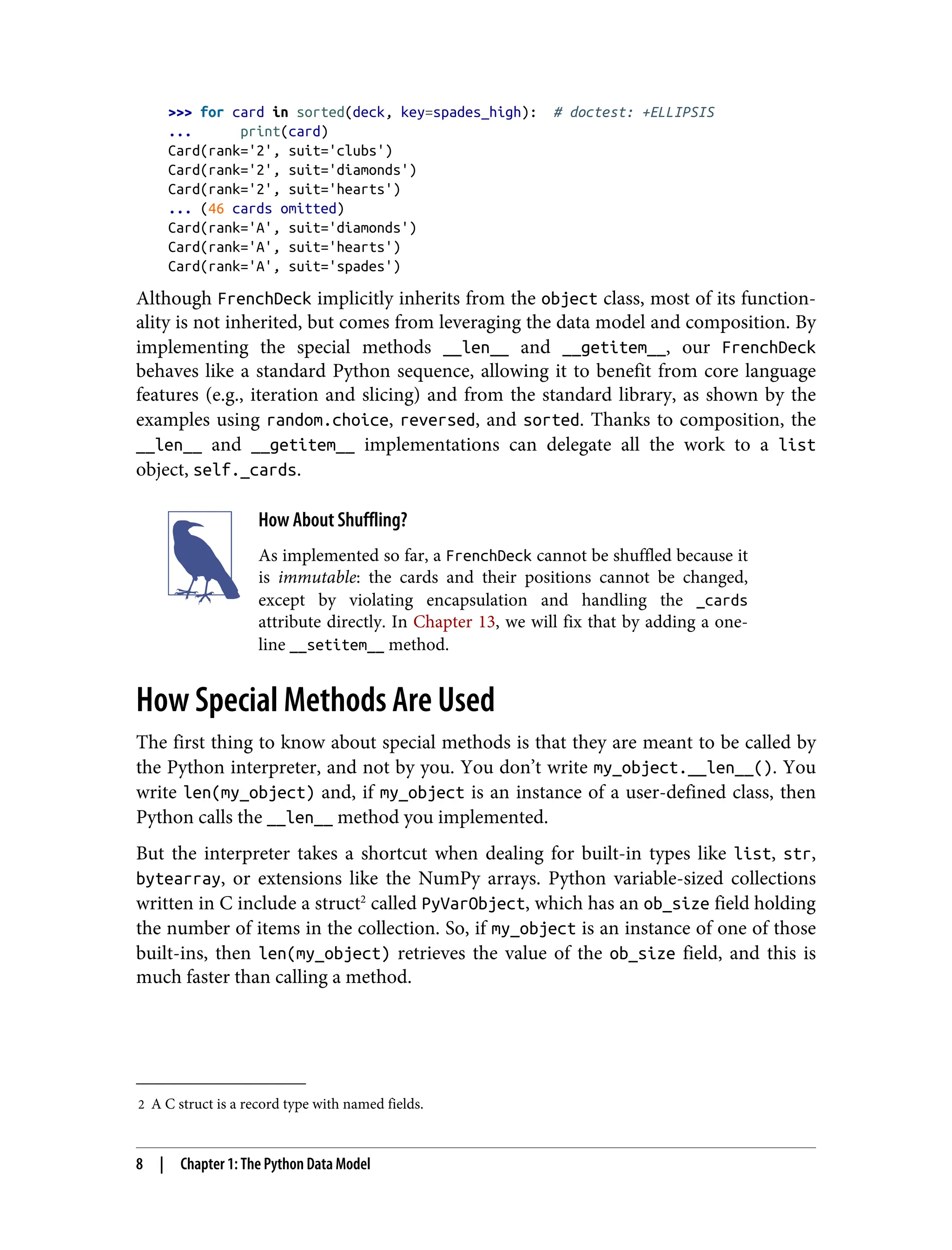

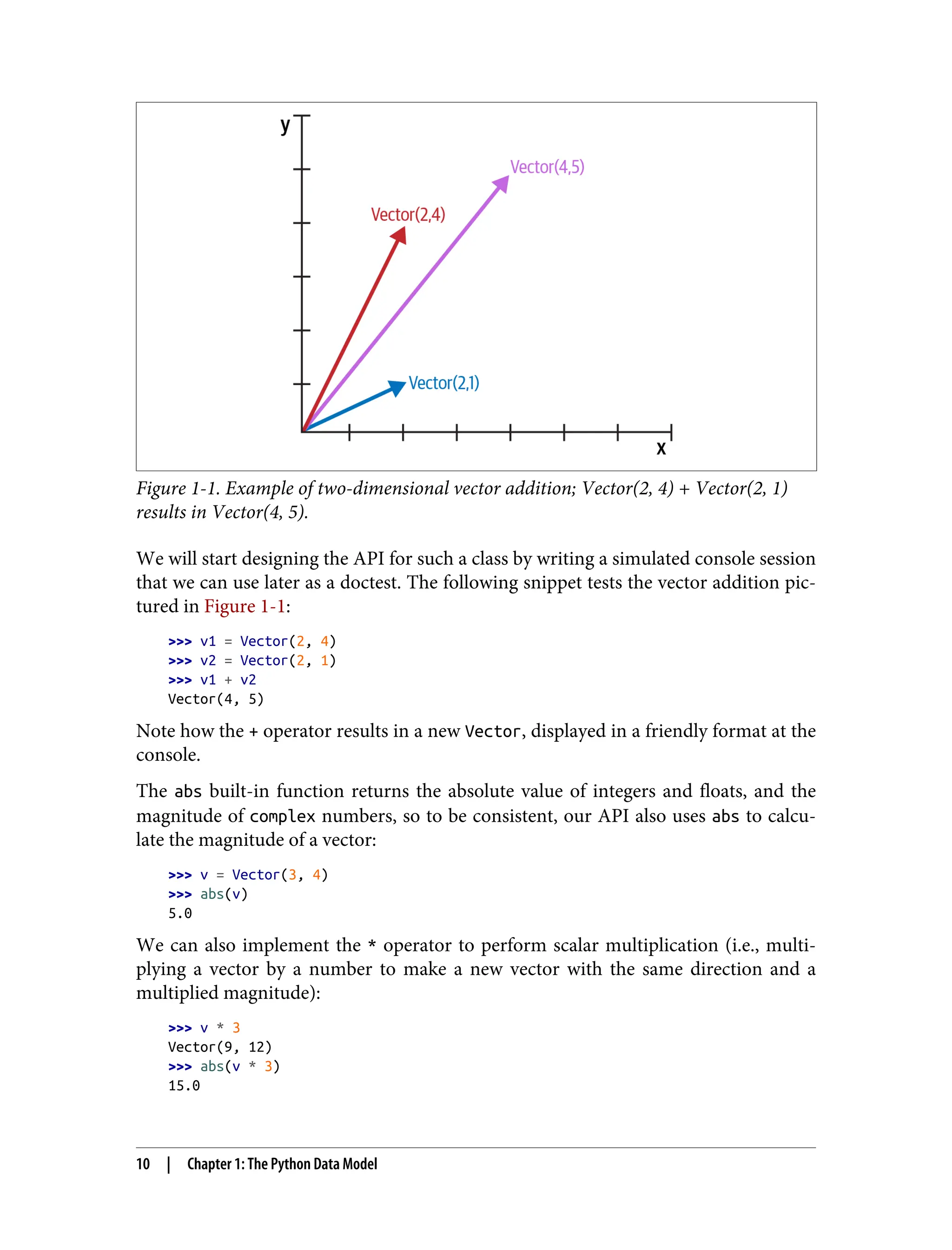
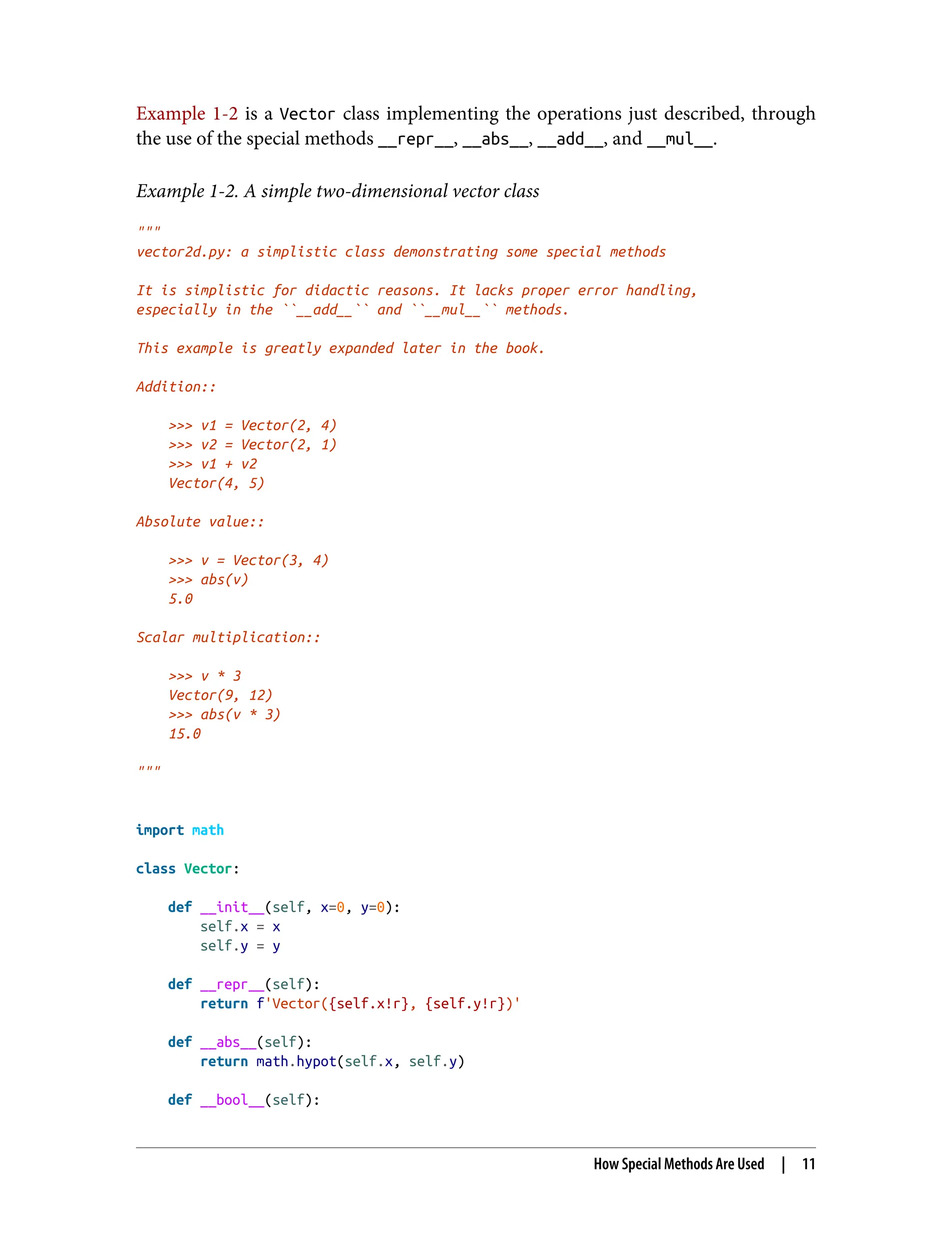
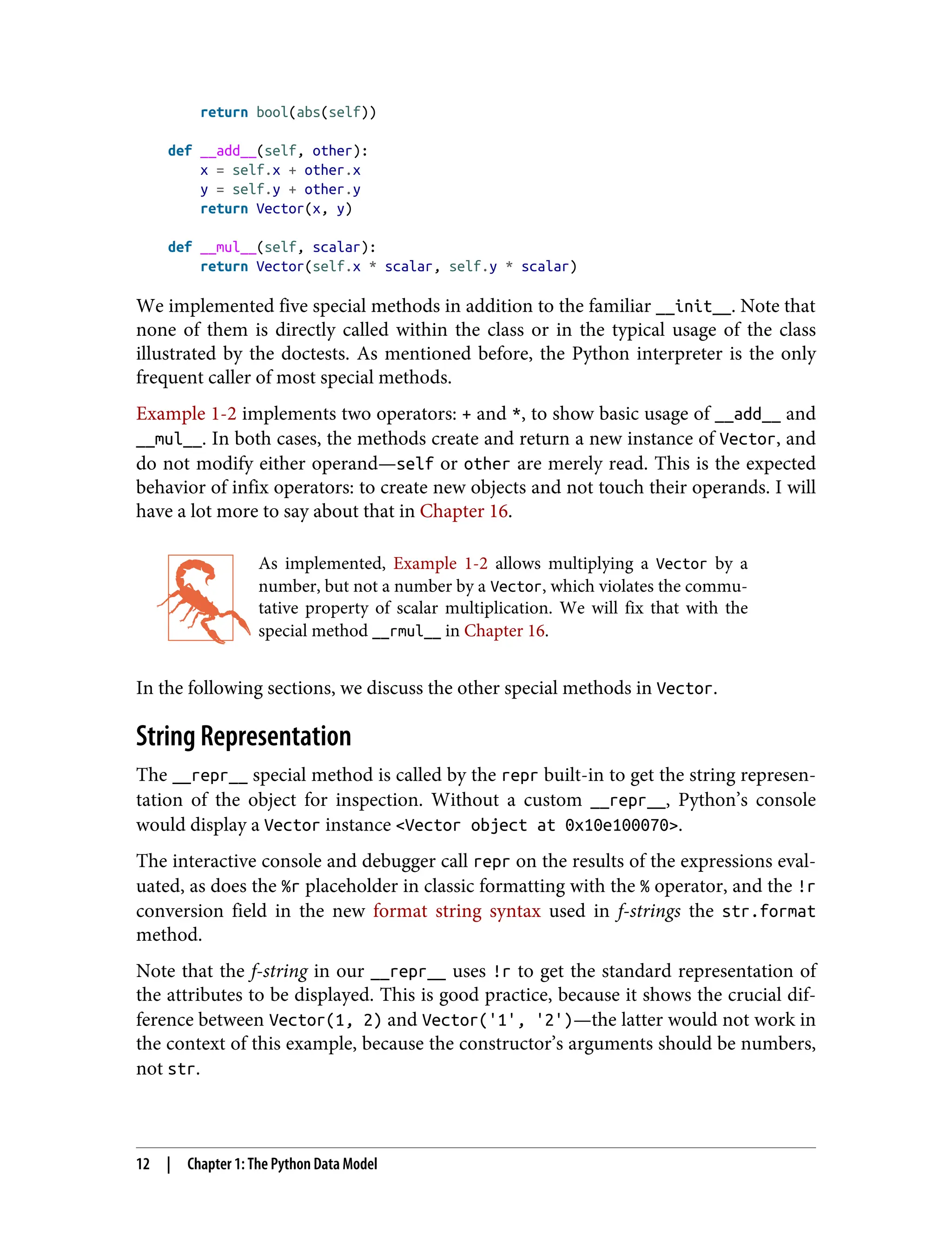

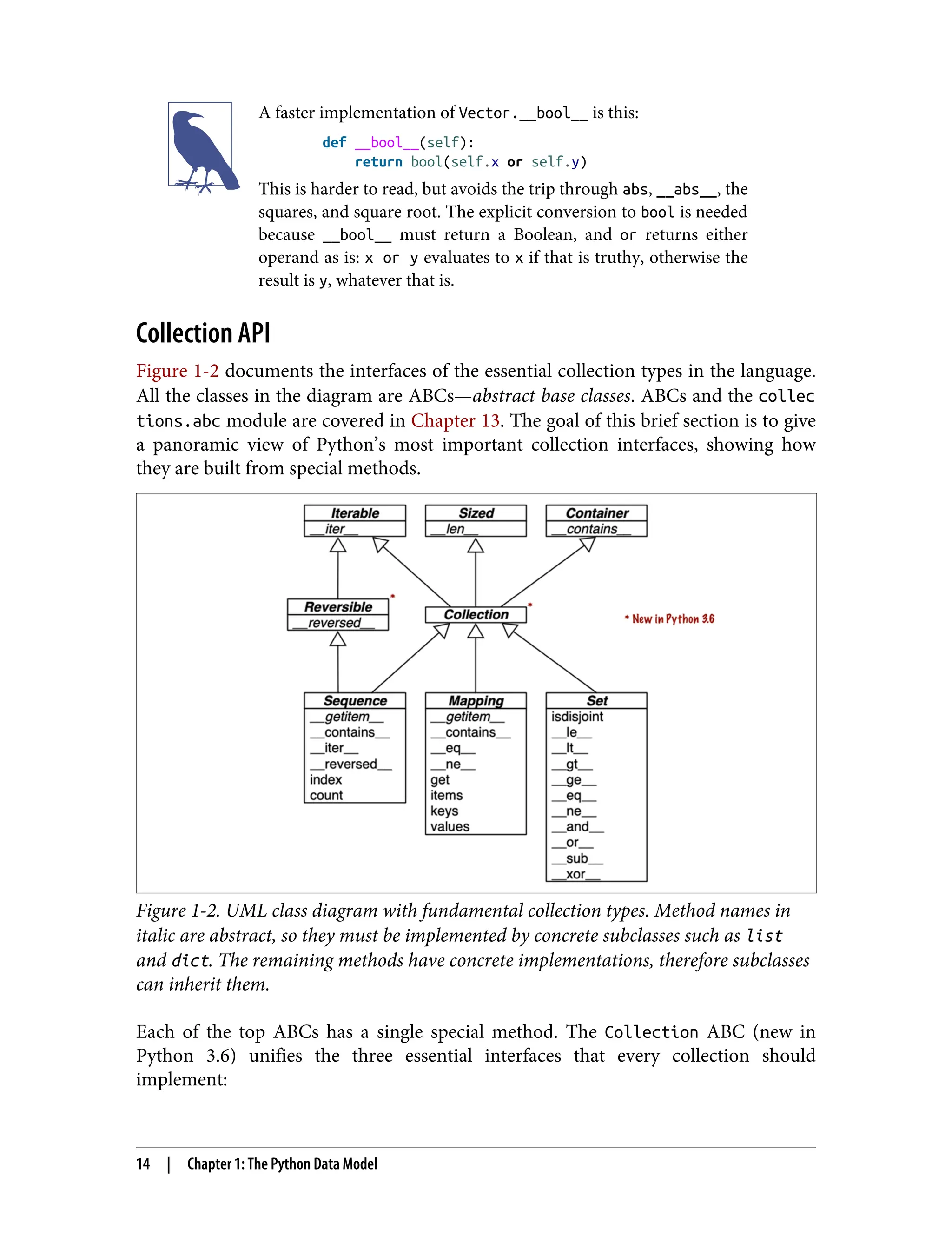
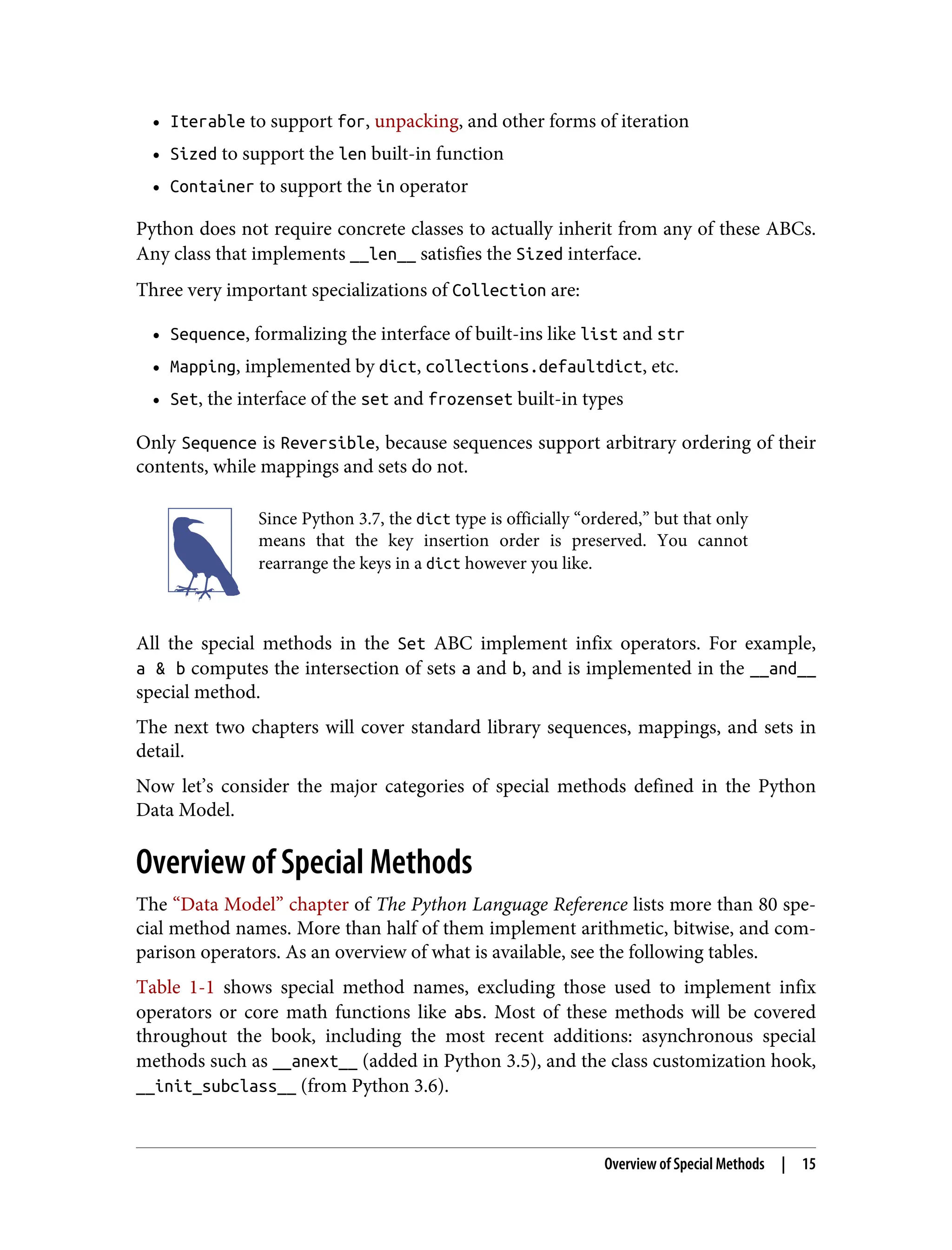

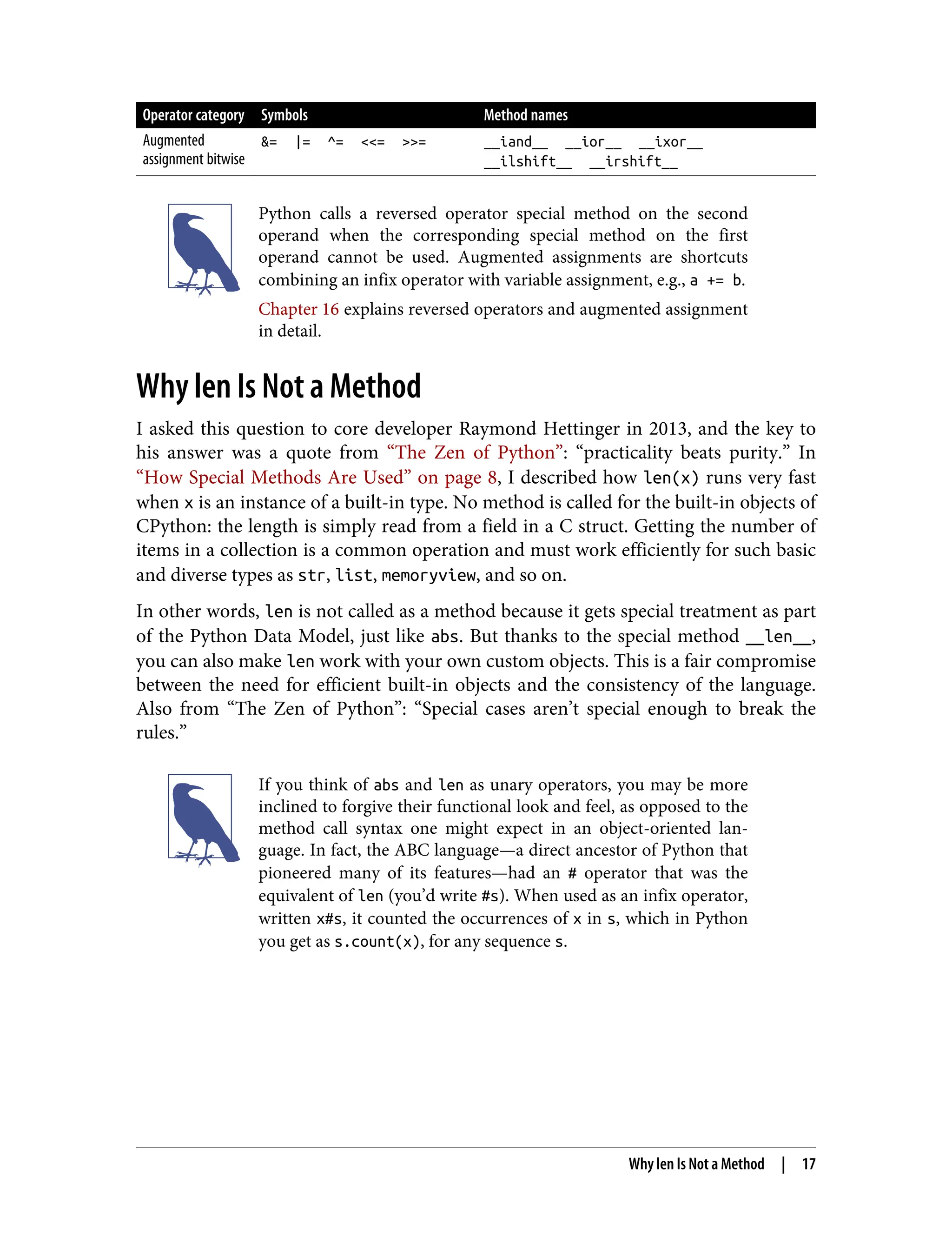
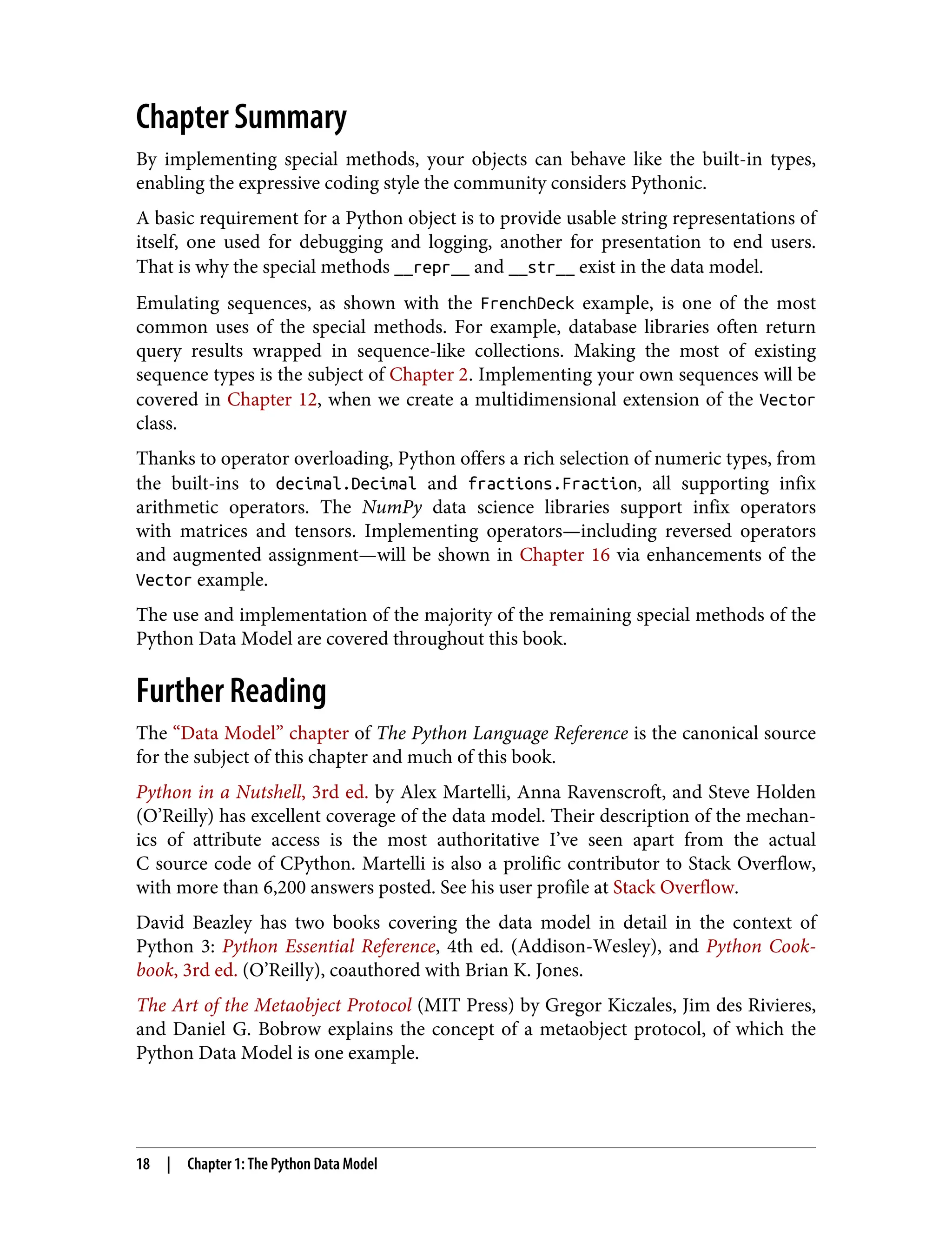
![Soapbox Data Model or Object Model? What the Python documentation calls the “Python Data Model,” most authors would say is the “Python object model.” Martelli, Ravenscroft, and Holden’s Python in a Nutshell, 3rd ed., and David Beazley’s Python Essential Reference, 4th ed. are the best books covering the Python Data Model, but they refer to it as the “object model.” On Wikipedia, the first definition of “object model” is: “The properties of objects in gen‐ eral in a specific computer programming language.” This is what the Python Data Model is about. In this book, I will use “data model” because the documentation favors that term when referring to the Python object model, and because it is the title of the chapter of The Python Language Reference most relevant to our discussions. Muggle Methods The Original Hacker’s Dictionary defines magic as “yet unexplained, or too compli‐ cated to explain” or “a feature not generally publicized which allows something other‐ wise impossible.” The Ruby community calls their equivalent of the special methods magic methods. Many in the Python community adopt that term as well. I believe the special methods are the opposite of magic. Python and Ruby empower their users with a rich metaob‐ ject protocol that is fully documented, enabling muggles like you and me to emulate many of the features available to core developers who write the interpreters for those languages. In contrast, consider Go. Some objects in that language have features that are magic, in the sense that we cannot emulate them in our own user-defined types. For exam‐ ple, Go arrays, strings, and maps support the use brackets for item access, as in a[i]. But there’s no way to make the [] notation work with a new collection type that you define. Even worse, Go has no user-level concept of an iterable interface or an iterator object, therefore its for/range syntax is limited to supporting five “magic” built-in types, including arrays, strings, and maps. Maybe in the future, the designers of Go will enhance its metaobject protocol. But currently, it is much more limited than what we have in Python or Ruby. Metaobjects The Art of the Metaobject Protocol (AMOP) is my favorite computer book title. But I mention it because the term metaobject protocol is useful to think about the Python Data Model and similar features in other languages. The metaobject part refers to the objects that are the building blocks of the language itself. In this context, protocol is a synonym of interface. So a metaobject protocol is a fancy synonym for object model: an API for core language constructs. Further Reading | 19](https://image.slidesharecdn.com/21445245-250528041545-5f2101ef/75/Fluent-Python-Clear-Concise-And-Effective-Programming-2nd-Edition-2nd-Luciano-Ramalho-53-2048.jpg)
